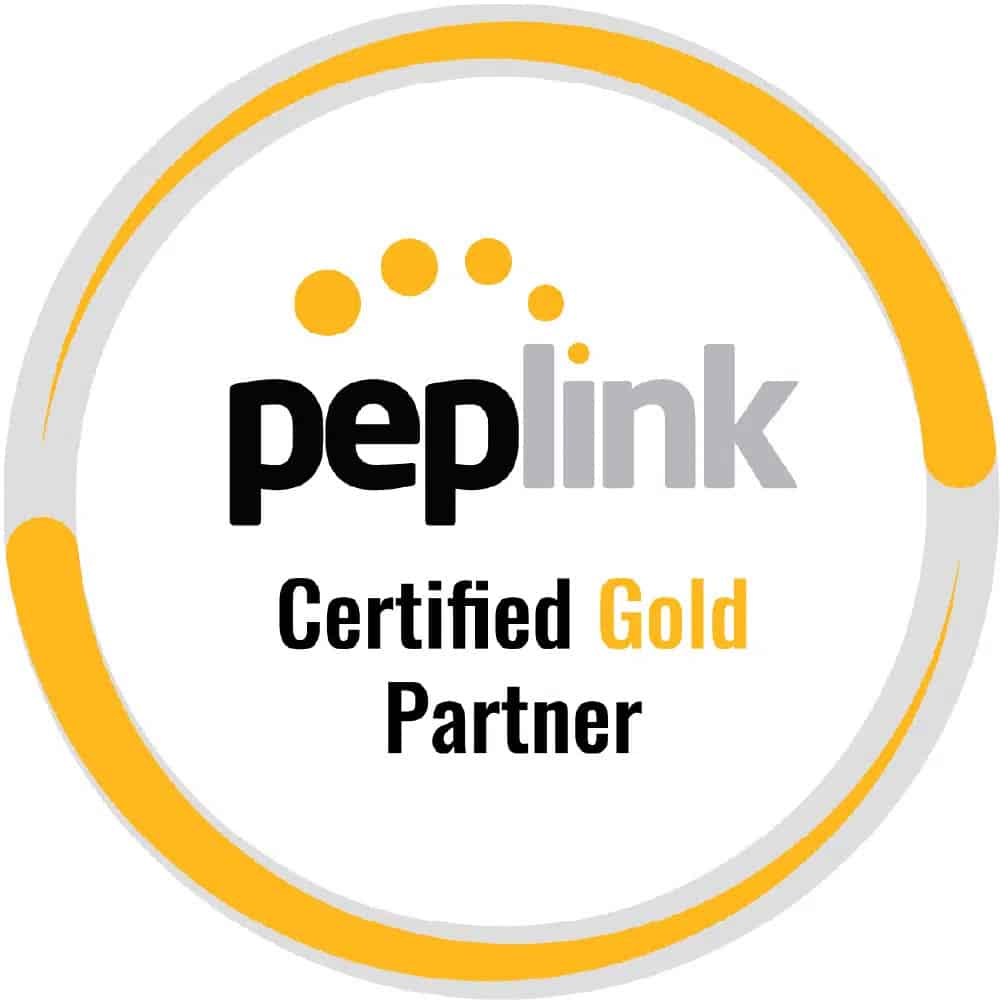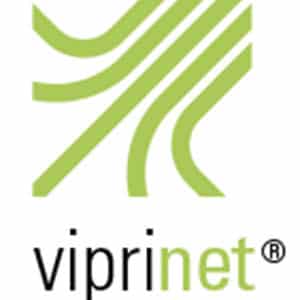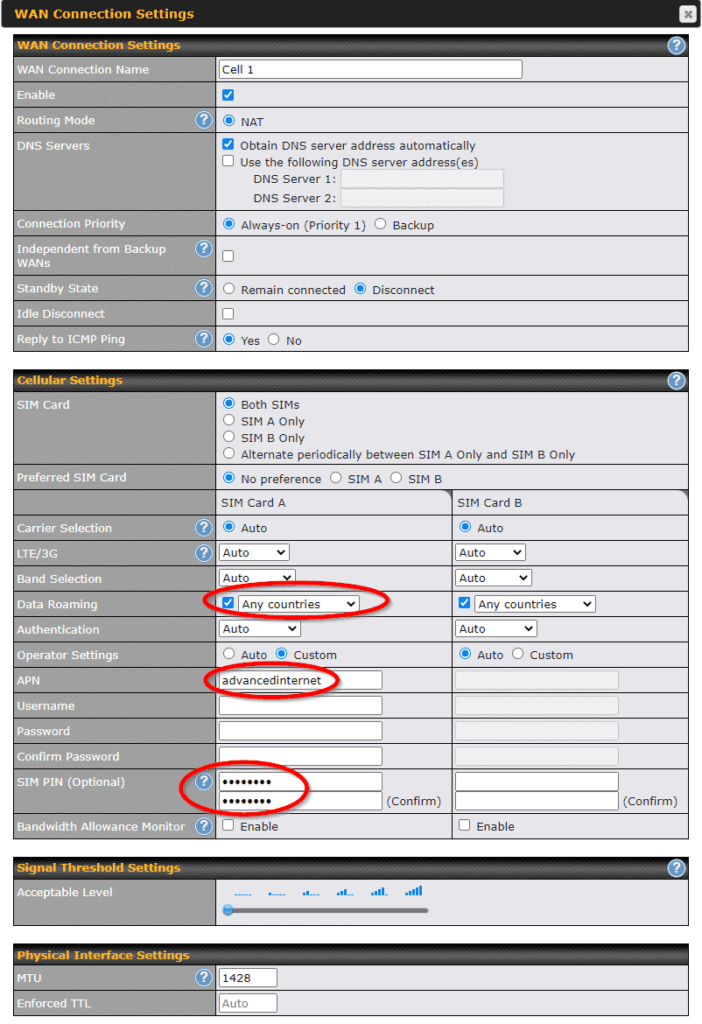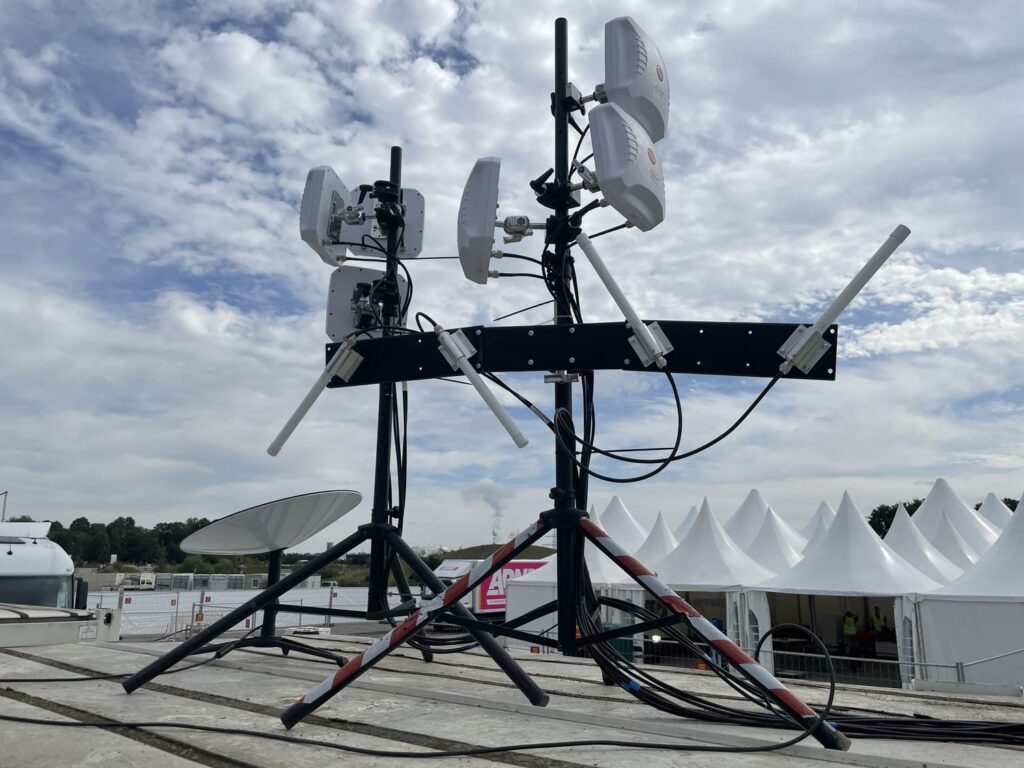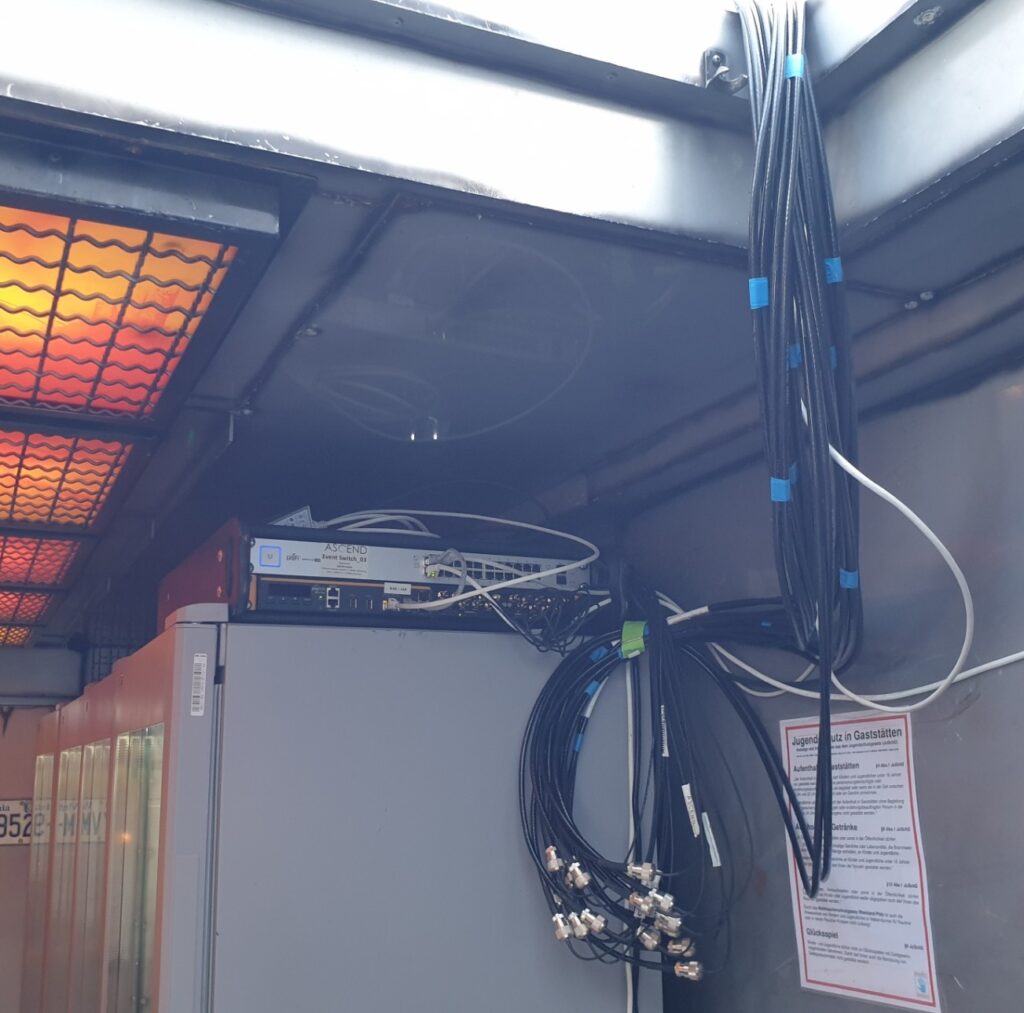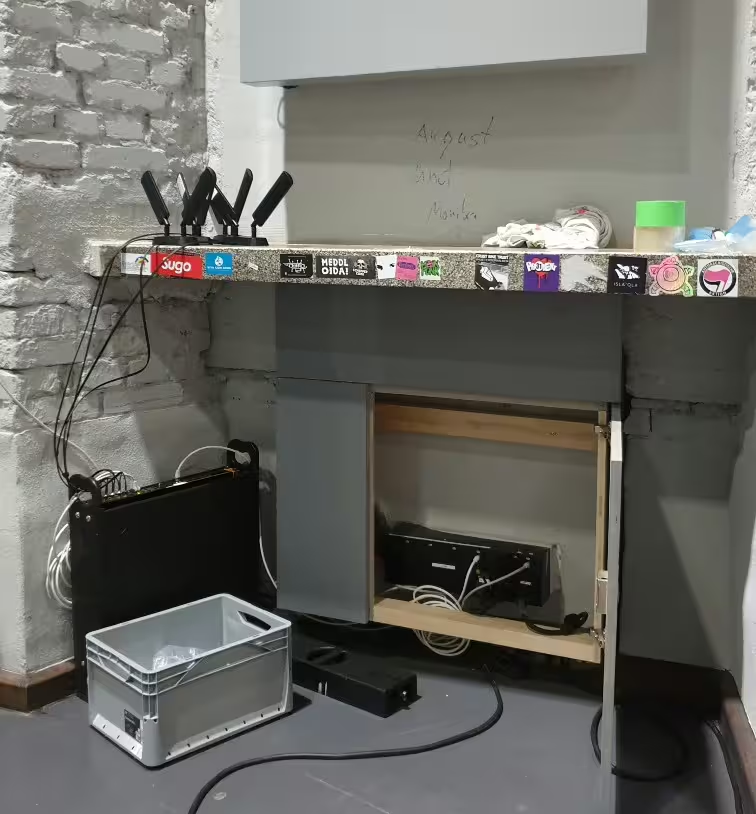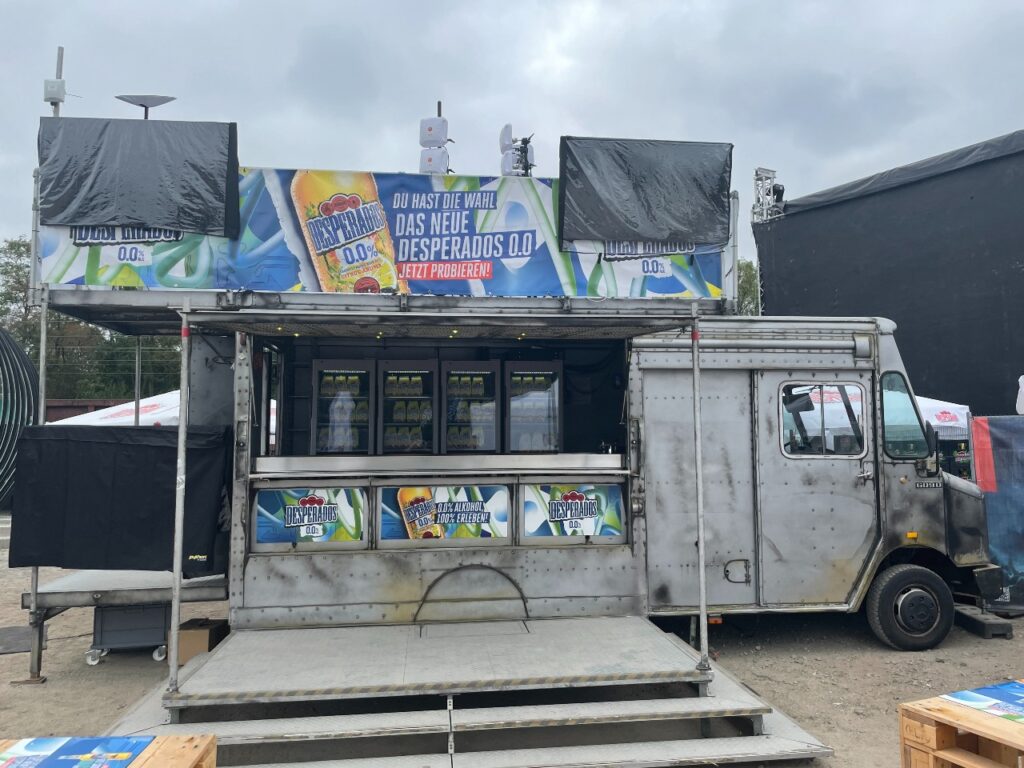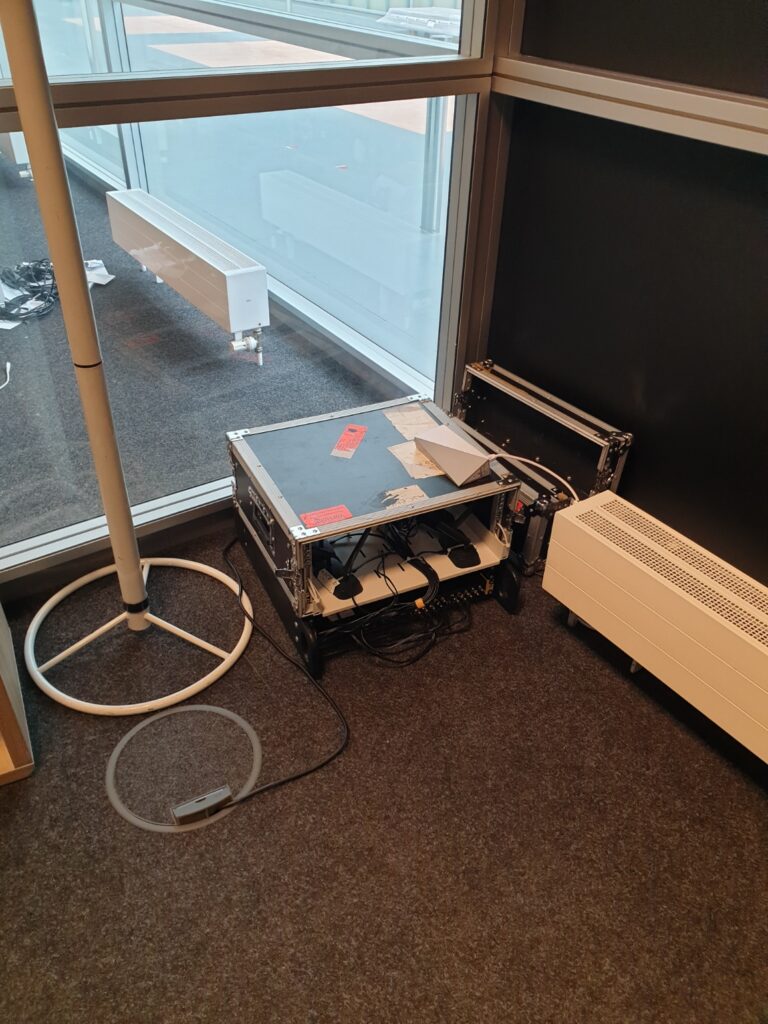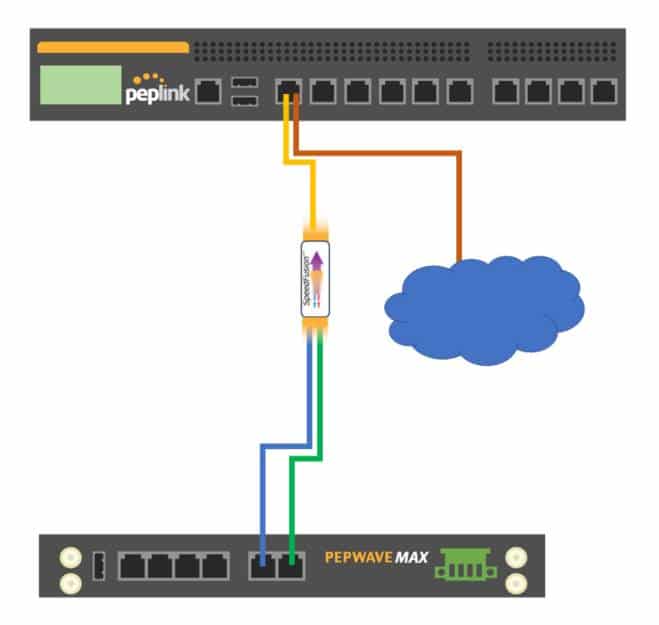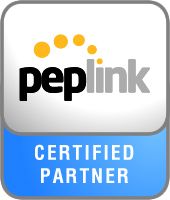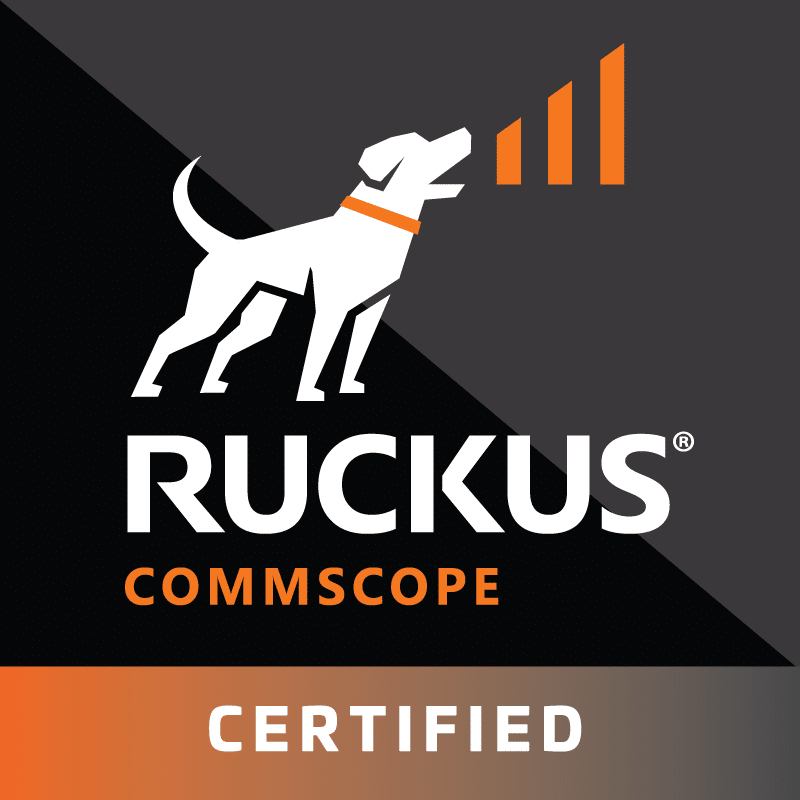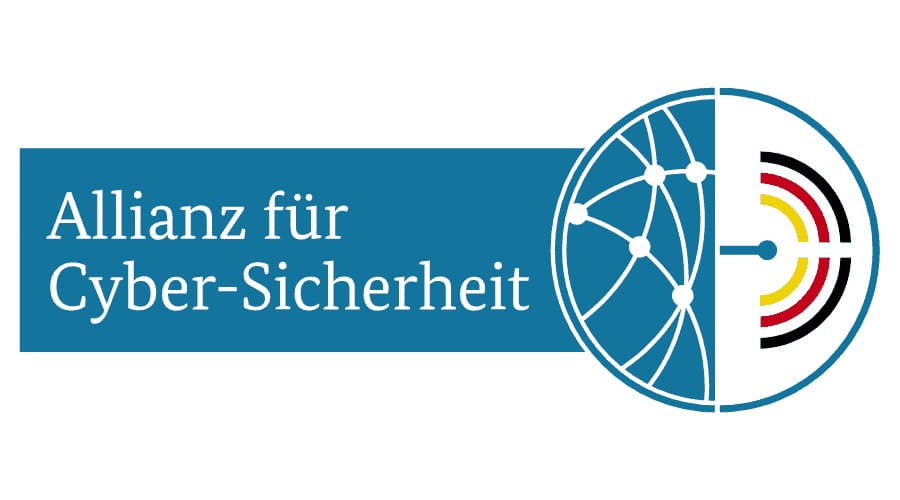Frequently asked questions (FAQ)
We have made every effort to provide you with as much information as we can.

3G/4G(LTE)/5G – Mobilfunk (1)
| Used in Germany | EXM-MBX-T2-5GD | Ribbon | Duplex mode[A 1] | ƒ (MHz) | Common name | Subset of band | Uplink[A 2] (MHz) | Downlink[A 3] (MHz) | Duplex spacing (MHz) | Channel bandwidths[A 4] (MHz) | Notes |
| GER | MBX5G | n1 | FDD | 2100 | IMT | 1920 - 1980 | 2110 - 2170 | 190 | 5, 10, 15, 20, 25, 30, 40, 45, 50 | ||
| MBX5G | n2 | FDD | 1900 | PCS | n25 | 1850 - 1910 | 1930 - 1990 | 80 | 5, 10, 15, 20, 25, 30, 35, 40 | ||
| MBX5G | n3 | FDD | 1800 | DCS | 1710 - 1785 | 1805 - 1880 | 95 | 5, 10, 15, 20, 25, 30, 35, 40, 45, 50 | |||
| MBX5G | n5 | FDD | 850 | CLR | n26 | 824 - 849 | 869 - 894 | 45 | 5, 10, 15, 20, 25[B 1] | ||
| MBX5G | n7 | FDD | 2600 | IMT-E | 2500 - 2570 | 2620 - 2690 | 120 | 5, 10, 15, 20, 25, 30, 35, 40, 50 | |||
| MBX5G | n8 | FDD | 900 | Extended GSM | 880 - 915 | 925 - 960 | 45 | 5, 10, 15, 20, 35[B 1] | |||
| MBX5G | n12 | FDD | 700 | Lower SMH | n85 | 699 - 716 | 729 - 746 | 30 | 5, 10, 15 | ||
| n13 | FDD | 700 | Upper SMH | 777 - 787 | 746 - 756 | -31 | 5, 10 | ||||
| n14 | FDD | 700 | Upper SMH | 788 - 798 | 758 - 768 | -30 | 5, 10 | ||||
| n18 | FDD | 850 | Lower 800 (Japan) | n26 | 815 - 830 | 860 - 875 | 45 | 5, 10, 15 | |||
| MBX5G | n20 | FDD | 800 | Digital Dividend (EU) | 832 - 862 | 791 - 821 | -41 | 5, 10, 15, 20 | |||
| n24 | FDD | 1600 | Upper L-Band (US) | 1626.5 - 1660.5[B 2] | 1525 - 1559[B 3] | -101.5 | 5, 10 | ||||
| n25 | FDD | 1900 | Extended PCS | 1850 - 1915 | 1930 - 1995 | 80 | 5, 10, 15, 20, 25, 30, 35, 40, 45[B 1] | ||||
| n26 | FDD | 850 | Extended CLR | 814 - 849 | 859 - 894 | 45 | 5, 10, 15, 20 | ||||
| n28 | FDD | 700 | APT | 703 - 748 | 758 - 803 | 55 | 5, 10, 15, 20, 30 | ||||
| n29 | SDL | 700 | Lower SMH | N/A | 717 - 728 | N/A | 5, 10 | ||||
| n30 | FDD | 2300 | WCS | 2305 - 2315 | 2350 - 2360 | 45 | 5, 10 | ||||
| n34 | TDD | 2100 | IMT | 2010 - 2025 | N/A | 5, 10, 15 | |||||
| MBX5G | n38 | TDD | 2600 | IMT-E[B 4] | 2570 - 2620 | N/A | 5, 10, 15, 20, 25, 30, 40 | ||||
| n39 | TDD | 1900 | DCS-IMT Gap | 1880 - 1920 | N/A | 5, 10, 15, 20, 25, 30, 40 | |||||
| n40 | TDD | 2300 | S-band | 2300 - 2400 | N/A | 5[B 5], 10, 15, 20, 25, 30, 40, 50, 60, 80, 90, 100 | |||||
| MBX5G | n41 | TDD | 2500 | BRS | 2496 - 2690 | N/A | 10, 15, 20, 30, 40, 50, 60, 70, 80, 90, 100 | ||||
| n46 | TDD | 5200 | U-NII-1-4 | 5150 - 5925 | N/A | 10[B 6], 20, 40, 60, 80 | LAA | ||||
| n47 | TDD | 5900 | U-NII-4 | 5855 - 5925 | N/A | 10, 20, 30, 40 | V2X | ||||
| n48 | TDD | 3500 | CBRS (US) | 3550 - 3700 | N/A | 5[B 5], 10, 15, 20, 30, 40, 50[B 6], 60[B 6], 70[B 6], 80[B 6], 90[B 6], 100[B 6] | |||||
| n50 | TDD | 1500 | L-band (EU) | 1432 - 1517 | N/A | 5[B 5], 10, 15, 20, 30, 40, 50, 60, 80[B 1] | |||||
| n51 | TDD | 1500 | L-Band Extension (EU) | 1427 - 1432 | N/A | 5 | |||||
| n53 | TDD | 2400 | S band | 2483.5 - 2495 | N/A | 5, 10 | |||||
| n65 | FDD | 2100 | Extended IMT | 1920 - 2010 | 2110 - 2200 | 190 | 5, 10, 15, 20, 50 | ||||
| MBX5G | n66 | FDD | 1700 2100 | Extended AWS | 1710 - 1780 | 2110 - 2200[B 7] | 400 | 5, 10, 15, 20, 25, 30, 35, 40, 45 | [B 8] | ||
| n67 | SDL | 700 | EU 700 | N/A | 738 - 758 | N/A | 5, 10, 15, 20 | ||||
| n70 | FDD | 2000 | Supplementary AWS | 1695 - 1710 | 1995 - 2020 | 300 | 5, 10, 15, 20[B 1], 25[B 1] | [B 8] | |||
| MBX5G | n71 | FDD | 600 | Digital Dividend (US) | 663 - 698 | 617 - 652 | -46 | 5, 10, 15, 20, 25[B 1], 30[B 1], 35[B 1] | [B 8] | ||
| n74 | FDD | 1500 | Lower L-Band (US) | 1427 - 1470 | 1475 - 1518 | 48 | 5, 10, 15, 20 | ||||
| n75 | SDL | 1500 | L-band (EU) | N/A | 1432 - 1517 | N/A | 5, 10, 15, 20, 25, 30, 40, 50 | ||||
| n76 | SDL | 1500 | Extended L-Band (EU) | N/A | 1427 - 1432 | N/A | 5 | ||||
| MBX5G | n77 | TDD | 3700 | C-Band | 3300 - 4200 | N/A | 10, 15, 20, 25, 30, 40, 50, 60, 70, 80, 90, 100 | ||||
| GER | MBX5G | n78 | TDD | 3500 | C-Band | n77 | 3300 - 3800 | N/A | 10, 15, 20, 25, 30, 40, 50, 60, 70, 80, 90, 100 | ||
| MBX5G | n79 | TDD | 4700 | C-Band | 4400 - 5000 | N/A | 10, 20, 30, 40, 50, 60, 70, 80, 90, 100 | ||||
| n80 | SUL | 1800 | DCS | 1710 - 1785 | N/A | N/A | 5, 10, 15, 20, 25, 30, 40 | ||||
| n81 | SUL | 900 | Extended GSM | 880 - 915 | N/A | N/A | 5, 10, 15, 20 | ||||
| n82 | SUL | 800 | Digital Dividend (EU) | 832 - 862 | N/A | N/A | 5, 10, 15, 20 | ||||
| n83 | SUL | 700 | APT | 703 - 748 | N/A | N/A | 5, 10, 15, 20, 30 | ||||
| n84 | SUL | 2100 | IMT | 1920 - 1980 | N/A | N/A | 5, 10, 15, 20, 25, 30, 40, 50 | ||||
| n85 | FDD | 700 | Extended Lower SMH | 698 - 716 | 728 - 746 | 30 | 5, 10, 15 | ||||
| n86 | SUL | 1700 | Extended AWS | n80 | 1710 - 1780 | N/A | N/A | 5, 10, 15, 20, 40 | |||
| n89 | SUL | 850 | CLR | 824 - 849 | N/A | N/A | 5, 10, 15, 20, 50 (sic) | ||||
| n90 | TDD | 2500 | BRS | n41 | 2496 - 2690 | N/A | 10, 15, 20, 30, 40, 50, 60, 80, 90, 100 | ||||
| n91 | FDD | 800 1500 | DD (EU) L-band (EU) | 832 - 862 | 1427 - 1432 | 570 - 595[B 9] | 5, 10[B 10] | [B 8] | |||
| n92 | FDD | 800 1500 | DD (EU) L-band (EU) | 832 - 862 | 1432 - 1517 | 600 - 660[B 9] | 5, 10, 15, 20 | [B 8] | |||
| n93 | FDD | 900 1500 | Extended GSM L-Band (EU) | 880 - 915 | 1427 - 1432 | 527 - 547[B 9] | 5, 10[B 10] | [B 8] | |||
| n94 | FDD | 900 1500 | Extended GSM L-Band (EU) | 880 - 915 | 1432 - 1517 | 532 - 632[B 9] | 5, 10, 15, 20 | [B 8] | |||
| n95 | SUL | 2100 | IMT | 2010 - 2025 | N/A | N/A | 5, 10, 15 | ||||
| n96 | TDD | 6000 | U-NII-5-9 | 5925 - 7125 | N/A | 20, 40, 60, 80 | LAA | ||||
| n97 | SUL | 2300 | S-band | 2300 - 2400 | N/A | N/A | 5, 10, 15, 20, 25, 30, 40, 50, 60, 70, 80, 90, 100 | ||||
| n98 | SUL | 1900 | DCS-IMT Gap | 1880 - 1920 | N/A | N/A | 5, 10, 15, 20, 25, 30, 40 | ||||
| n99 | SUL | 1600 | Upper L-Band (US) | 1626.5 - 1660.5[B 2] | N/A | N/A | 5, 10 |
| by Ascend GmbH | JF | 26.01.2022 | All statements without guarantee |
| Table Source: https://en.wikipedia.org/wiki/5G_NR_frequency_bands |
| MBX5G | Supported | according to: http://download.peplink.com/resources/pepwave_mbx_5g_5gd_datasheet.pdf |
| GER | Bands used in Germany | source: https://www.everythingrf.com/community/5g-frequency-spectrum-in-germany |
ASCEND Router SIM (4)
First of all, you need a SIM card that allows connections to other network providers, such as the"ASCEND Router SIM card".
If you have this, it is relatively simple.
Go to the web interface of your router at
Network --> WAN --> Cellular (or similar)
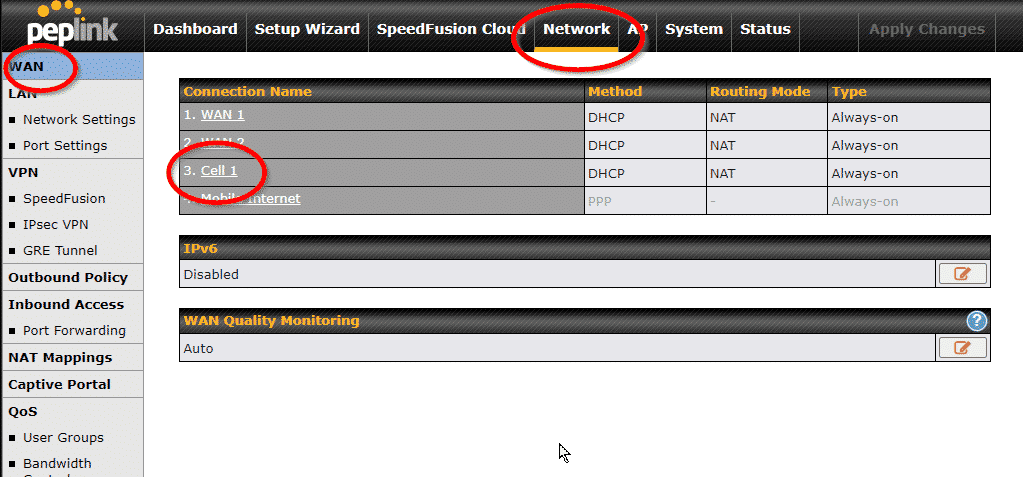
In the menu that now opens, you will find the"Carrier Selection" option relatively in the middle. Press the"question mark" here
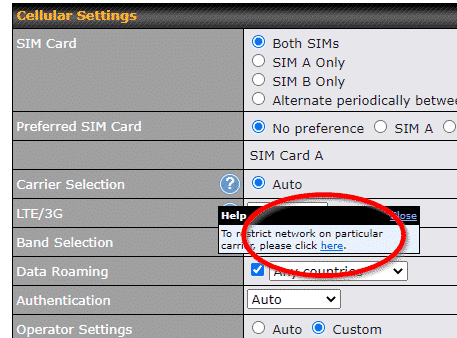
In the following dialog please click on"here"
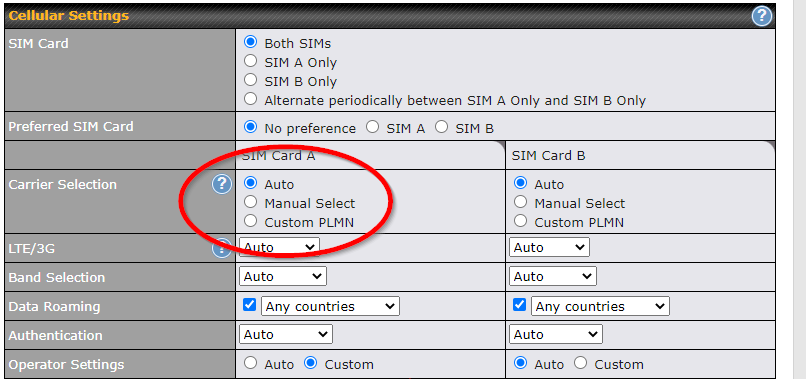
Then please select"Manual Select"
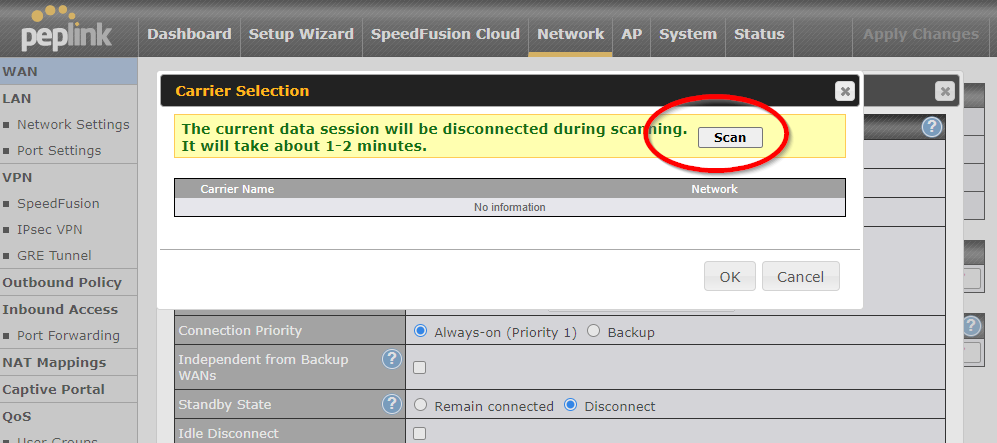
Please click on"Scan" in the following pop-up window
CAUTION: This module will go offline for the duration of the network search. If this is your only Internet connection and you perform this activity remotely (e.g. using InControl access), you will lose the Internet connection. It is therefore advisable to only do this if you have at least one other "healthy" Internet connection via which you can access the device or if you access the router locally via LAN.

Once the scanning process is complete, you can select the network provider and the card will now connect to it.
Switch off
Switch off the Balance 310X and disconnect it from the power supply.
Removing the cover
Remove the SIM card cover on the back of the device.
You do not need any special tools for this as it is easy to remove.
Inserting the SIM card
Carefully insert the SIM card into the slot provided (A).
Make sure that the cut-off corner of the SIM card is aligned with the
notch in the slot.
Replacing the cover
Replace the SIM card cover and press it on lightly until it clicks into place or secure it with a screw.
Switching the device on
Reconnect the Balance 310X to the power supply and switch it on.
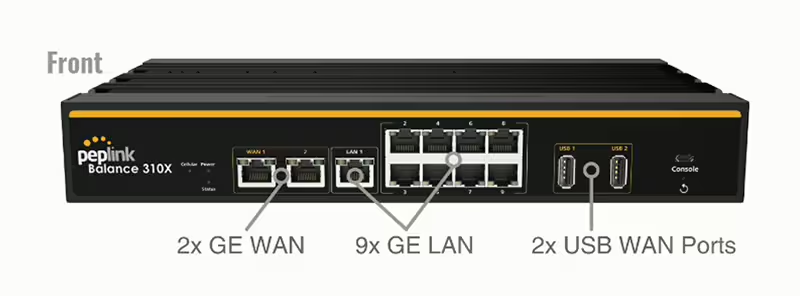
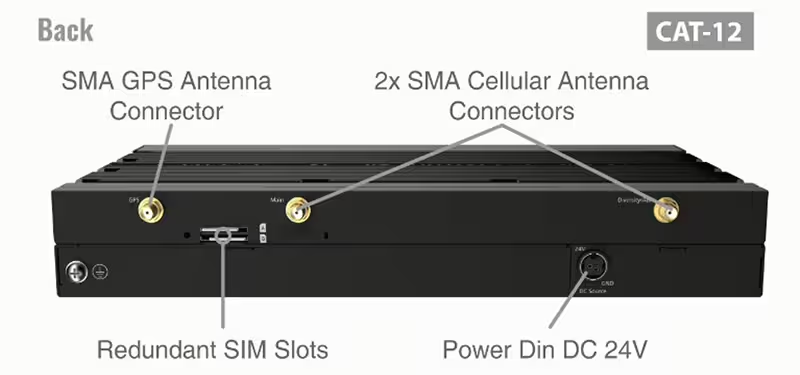
Bündelungs-Einstellungen (2)
The normal speed test usually takes around 20 seconds in each direction (upload and download).
It first measures the ping time, then the download and then the upload.
During the download and upload test, it no longer measures the latency (the ping).
This means that the runtime for the data packets is measured in idle mode.
Only then is the line put under load.
Only under load do the lines usually react more slowly than when idle.
If you have nothing to do, you will reply to emails faster than if you have a full desk.
However, as latency is critical for real-time applications, the router automatically tries to keep the latency in a low range.
This means that it throttles the data rate if the latency exceeds a certain value.
The same applies to packet loss.
It attempts to minimize packet loss and latency using intelligent algorithms to ensure maximum stability.
In addition, the duration of 20 seconds is too short to correctly measure and level several bundled lines. By the time the router has collected the required data, which takes around 45 seconds, the data stream is already over.
You should therefore only carry out tunnel speed tests with the integrated speed test or WAN analyzer with a minimum duration of 60 seconds. These values are reliable in any case. A speed test from a cell phone is at best an indication of "whether anything works at all".
You can find detailed information in the Speedfusion Deep-Dive from Peplink. Here: whitepaper-speedfusion-and-best-practices-2019_deutsch.pdf
WAN smoothing with Peplink means that the data is transmitted redundantly over several lines.
Depending on the smoothing mode, this ranges from double to the number of WAN connections.
However, if the stream still has connection interruptions, there may be several reasons for this.
- The hub must be connected via a stable internet connection. We strongly recommend a hub in a data center. You are welcome to host these streaming-optimized VPN hubs in our data center.
- If no line is available at your location, or if all lines are so poor despite redundancy that the same data packets are lost on all lines at the same time, then the router can no longer compensate for this. However, this case is fortunately rather rare in practice. In this case, it can help to switch off WAN smoothing and switch to bundling mode and reduce the bit rate of the encoder.
Event FAQ (3)
Depending on the solution, from 1 to infinity.
dispatch solutions we generally recommend up to 250 simultaneous users.
For larger events, it is usually better if we come and install and commission the high-performance routers, switches and WLAN access points ourselves.
In general, there is no limit to the number of users, you just have to make sure that the internet bandwidth available on site is sufficient.
Internetverbindungen (3)
| Used in Germany | EXM-MBX-T2-5GD | Ribbon | Duplex mode[A 1] | ƒ (MHz) | Common name | Subset of band | Uplink[A 2] (MHz) | Downlink[A 3] (MHz) | Duplex spacing (MHz) | Channel bandwidths[A 4] (MHz) | Notes |
| GER | MBX5G | n1 | FDD | 2100 | IMT | 1920 - 1980 | 2110 - 2170 | 190 | 5, 10, 15, 20, 25, 30, 40, 45, 50 | ||
| MBX5G | n2 | FDD | 1900 | PCS | n25 | 1850 - 1910 | 1930 - 1990 | 80 | 5, 10, 15, 20, 25, 30, 35, 40 | ||
| MBX5G | n3 | FDD | 1800 | DCS | 1710 - 1785 | 1805 - 1880 | 95 | 5, 10, 15, 20, 25, 30, 35, 40, 45, 50 | |||
| MBX5G | n5 | FDD | 850 | CLR | n26 | 824 - 849 | 869 - 894 | 45 | 5, 10, 15, 20, 25[B 1] | ||
| MBX5G | n7 | FDD | 2600 | IMT-E | 2500 - 2570 | 2620 - 2690 | 120 | 5, 10, 15, 20, 25, 30, 35, 40, 50 | |||
| MBX5G | n8 | FDD | 900 | Extended GSM | 880 - 915 | 925 - 960 | 45 | 5, 10, 15, 20, 35[B 1] | |||
| MBX5G | n12 | FDD | 700 | Lower SMH | n85 | 699 - 716 | 729 - 746 | 30 | 5, 10, 15 | ||
| n13 | FDD | 700 | Upper SMH | 777 - 787 | 746 - 756 | -31 | 5, 10 | ||||
| n14 | FDD | 700 | Upper SMH | 788 - 798 | 758 - 768 | -30 | 5, 10 | ||||
| n18 | FDD | 850 | Lower 800 (Japan) | n26 | 815 - 830 | 860 - 875 | 45 | 5, 10, 15 | |||
| MBX5G | n20 | FDD | 800 | Digital Dividend (EU) | 832 - 862 | 791 - 821 | -41 | 5, 10, 15, 20 | |||
| n24 | FDD | 1600 | Upper L-Band (US) | 1626.5 - 1660.5[B 2] | 1525 - 1559[B 3] | -101.5 | 5, 10 | ||||
| n25 | FDD | 1900 | Extended PCS | 1850 - 1915 | 1930 - 1995 | 80 | 5, 10, 15, 20, 25, 30, 35, 40, 45[B 1] | ||||
| n26 | FDD | 850 | Extended CLR | 814 - 849 | 859 - 894 | 45 | 5, 10, 15, 20 | ||||
| n28 | FDD | 700 | APT | 703 - 748 | 758 - 803 | 55 | 5, 10, 15, 20, 30 | ||||
| n29 | SDL | 700 | Lower SMH | N/A | 717 - 728 | N/A | 5, 10 | ||||
| n30 | FDD | 2300 | WCS | 2305 - 2315 | 2350 - 2360 | 45 | 5, 10 | ||||
| n34 | TDD | 2100 | IMT | 2010 - 2025 | N/A | 5, 10, 15 | |||||
| MBX5G | n38 | TDD | 2600 | IMT-E[B 4] | 2570 - 2620 | N/A | 5, 10, 15, 20, 25, 30, 40 | ||||
| n39 | TDD | 1900 | DCS-IMT Gap | 1880 - 1920 | N/A | 5, 10, 15, 20, 25, 30, 40 | |||||
| n40 | TDD | 2300 | S-band | 2300 - 2400 | N/A | 5[B 5], 10, 15, 20, 25, 30, 40, 50, 60, 80, 90, 100 | |||||
| MBX5G | n41 | TDD | 2500 | BRS | 2496 - 2690 | N/A | 10, 15, 20, 30, 40, 50, 60, 70, 80, 90, 100 | ||||
| n46 | TDD | 5200 | U-NII-1-4 | 5150 - 5925 | N/A | 10[B 6], 20, 40, 60, 80 | LAA | ||||
| n47 | TDD | 5900 | U-NII-4 | 5855 - 5925 | N/A | 10, 20, 30, 40 | V2X | ||||
| n48 | TDD | 3500 | CBRS (US) | 3550 - 3700 | N/A | 5[B 5], 10, 15, 20, 30, 40, 50[B 6], 60[B 6], 70[B 6], 80[B 6], 90[B 6], 100[B 6] | |||||
| n50 | TDD | 1500 | L-band (EU) | 1432 - 1517 | N/A | 5[B 5], 10, 15, 20, 30, 40, 50, 60, 80[B 1] | |||||
| n51 | TDD | 1500 | L-Band Extension (EU) | 1427 - 1432 | N/A | 5 | |||||
| n53 | TDD | 2400 | S band | 2483.5 - 2495 | N/A | 5, 10 | |||||
| n65 | FDD | 2100 | Extended IMT | 1920 - 2010 | 2110 - 2200 | 190 | 5, 10, 15, 20, 50 | ||||
| MBX5G | n66 | FDD | 1700 2100 | Extended AWS | 1710 - 1780 | 2110 - 2200[B 7] | 400 | 5, 10, 15, 20, 25, 30, 35, 40, 45 | [B 8] | ||
| n67 | SDL | 700 | EU 700 | N/A | 738 - 758 | N/A | 5, 10, 15, 20 | ||||
| n70 | FDD | 2000 | Supplementary AWS | 1695 - 1710 | 1995 - 2020 | 300 | 5, 10, 15, 20[B 1], 25[B 1] | [B 8] | |||
| MBX5G | n71 | FDD | 600 | Digital Dividend (US) | 663 - 698 | 617 - 652 | -46 | 5, 10, 15, 20, 25[B 1], 30[B 1], 35[B 1] | [B 8] | ||
| n74 | FDD | 1500 | Lower L-Band (US) | 1427 - 1470 | 1475 - 1518 | 48 | 5, 10, 15, 20 | ||||
| n75 | SDL | 1500 | L-band (EU) | N/A | 1432 - 1517 | N/A | 5, 10, 15, 20, 25, 30, 40, 50 | ||||
| n76 | SDL | 1500 | Extended L-Band (EU) | N/A | 1427 - 1432 | N/A | 5 | ||||
| MBX5G | n77 | TDD | 3700 | C-Band | 3300 - 4200 | N/A | 10, 15, 20, 25, 30, 40, 50, 60, 70, 80, 90, 100 | ||||
| GER | MBX5G | n78 | TDD | 3500 | C-Band | n77 | 3300 - 3800 | N/A | 10, 15, 20, 25, 30, 40, 50, 60, 70, 80, 90, 100 | ||
| MBX5G | n79 | TDD | 4700 | C-Band | 4400 - 5000 | N/A | 10, 20, 30, 40, 50, 60, 70, 80, 90, 100 | ||||
| n80 | SUL | 1800 | DCS | 1710 - 1785 | N/A | N/A | 5, 10, 15, 20, 25, 30, 40 | ||||
| n81 | SUL | 900 | Extended GSM | 880 - 915 | N/A | N/A | 5, 10, 15, 20 | ||||
| n82 | SUL | 800 | Digital Dividend (EU) | 832 - 862 | N/A | N/A | 5, 10, 15, 20 | ||||
| n83 | SUL | 700 | APT | 703 - 748 | N/A | N/A | 5, 10, 15, 20, 30 | ||||
| n84 | SUL | 2100 | IMT | 1920 - 1980 | N/A | N/A | 5, 10, 15, 20, 25, 30, 40, 50 | ||||
| n85 | FDD | 700 | Extended Lower SMH | 698 - 716 | 728 - 746 | 30 | 5, 10, 15 | ||||
| n86 | SUL | 1700 | Extended AWS | n80 | 1710 - 1780 | N/A | N/A | 5, 10, 15, 20, 40 | |||
| n89 | SUL | 850 | CLR | 824 - 849 | N/A | N/A | 5, 10, 15, 20, 50 (sic) | ||||
| n90 | TDD | 2500 | BRS | n41 | 2496 - 2690 | N/A | 10, 15, 20, 30, 40, 50, 60, 80, 90, 100 | ||||
| n91 | FDD | 800 1500 | DD (EU) L-band (EU) | 832 - 862 | 1427 - 1432 | 570 - 595[B 9] | 5, 10[B 10] | [B 8] | |||
| n92 | FDD | 800 1500 | DD (EU) L-band (EU) | 832 - 862 | 1432 - 1517 | 600 - 660[B 9] | 5, 10, 15, 20 | [B 8] | |||
| n93 | FDD | 900 1500 | Extended GSM L-Band (EU) | 880 - 915 | 1427 - 1432 | 527 - 547[B 9] | 5, 10[B 10] | [B 8] | |||
| n94 | FDD | 900 1500 | Extended GSM L-Band (EU) | 880 - 915 | 1432 - 1517 | 532 - 632[B 9] | 5, 10, 15, 20 | [B 8] | |||
| n95 | SUL | 2100 | IMT | 2010 - 2025 | N/A | N/A | 5, 10, 15 | ||||
| n96 | TDD | 6000 | U-NII-5-9 | 5925 - 7125 | N/A | 20, 40, 60, 80 | LAA | ||||
| n97 | SUL | 2300 | S-band | 2300 - 2400 | N/A | N/A | 5, 10, 15, 20, 25, 30, 40, 50, 60, 70, 80, 90, 100 | ||||
| n98 | SUL | 1900 | DCS-IMT Gap | 1880 - 1920 | N/A | N/A | 5, 10, 15, 20, 25, 30, 40 | ||||
| n99 | SUL | 1600 | Upper L-Band (US) | 1626.5 - 1660.5[B 2] | N/A | N/A | 5, 10 |
| by Ascend GmbH | JF | 26.01.2022 | All statements without guarantee |
| Table Source: https://en.wikipedia.org/wiki/5G_NR_frequency_bands |
| MBX5G | Supported | according to: http://download.peplink.com/resources/pepwave_mbx_5g_5gd_datasheet.pdf |
| GER | Bands used in Germany | source: https://www.everythingrf.com/community/5g-frequency-spectrum-in-germany |
WAN bonding and WAN balancing are two different approaches to improving the performance and reliability of wide area networks (WANs) used to connect remote sites, data centers and branch offices. Here are the differences between the two concepts:
WAN bonding (WAN bonding):
WAN bundling refers to the aggregation of multiple WAN connections into a single logical channel. In this approach, two or more separate WAN connections (e.g. DSL, cable, 4G/5G, leased lines) are combined into a single logical path. The bundled connection uses all existing connections in parallel to increase the overall data transfer rate. Special hardware or software technologies are used to merge the connections and achieve better throughput. WAN bundling provides increased bandwidth and improves connection reliability, as the failures of individual connections can often be intercepted by other remaining connections.
WAN balancing (WAN load balancing):
WAN balancing refers to the even distribution of data traffic across multiple WAN connections. In contrast to bundling, the individual connections are not aggregated, but the data traffic is distributed across several connections in order to balance the load. Load balancing can be carried out in various ways, e.g. by protocol, application, IP address or port number. The aim is to optimize network performance by distributing data traffic across the available connections in order to avoid overloads and ensure efficient use of bandwidth.
To summarize, WAN bonding aggregates connections to increase overall bandwidth and resiliency, while WAN balancing distributes traffic across multiple connections to achieve optimal load balancing and performance. The choice between the two depends on a company's specific requirements and available network resources.
IT System House (9)
System house services include a variety of IT services aimed at optimizing and operating the IT infrastructure of companies.
A system house such as ASCEND GmbH from Nuremberg offers the following services:
- IT consulting and planning: analysis of IT requirements and development of customized IT solutions.
- Network management: Implementation, management and maintenance of networks for a stable and secure connection.
- IT security: protection of the IT infrastructure through firewalls, antivirus software and data encryption.
- Managed Services: Proactive monitoring and management of IT systems to maximize efficiency and minimize downtime.
- Hardware and software support: Support with the selection, implementation and maintenance of hardware and software.
- Cloud services: Provision and management of cloud solutions for flexibility and scalability.
- WLAN solutions: Planning and implementation of WLAN infrastructures for offices, events and mobile workstations.
These services are designed to help companies operate their IT systems efficiently and optimize them continuously.
A system house, such as ASCEND GmbH from Nuremberg, offers a comprehensive range of IT services and solutions that are specially tailored to the needs of companies.
The main tasks of a system house include
- IT consulting and planning: analysis of IT requirements and development of customized IT solutions.
- Network management: Implementation and maintenance of networks for stable and secure connections.
- IT security: protection of the IT infrastructure through firewalls, antivirus software and data encryption.
- Managed Services: Proactive monitoring and management of IT systems to maximize efficiency and minimize downtime.
- Hardware and software support: Advice on the selection and implementation of suitable hardware and software.
- Cloud services: Provision and management of cloud solutions for flexibility and scalability.
- WLAN solutions: Planning and implementation of WLAN infrastructures for offices, events and mobile workstations.
ASCEND helps companies to make their IT infrastructure efficient and future-proof by providing continuous support and customized solutions.
The costs for the services of an IT system house such as ASCEND GmbH from Nuremberg can vary greatly and depend on various factors.
These include the scope of the services required, the size of the company and the specific requirements of the IT infrastructure.
Basically, the costs cover the following areas:
- IT consulting and planning: We analyze the specific needs of your company and develop tailor-made IT solutions.
- Implementation and installation: The cost of setting up and configuring networks, servers, software and security systems.
- Managed services: Ongoing maintenance and monitoring of the IT infrastructure, including support and updates.
- IT security: Implementation of security measures such as firewalls, antivirus software and data encryption.
- Licenses and hardware: Costs for software licenses and the purchase of hardware such as servers, computers and network equipment.
You will usually receive a detailed cost breakdown after an initial consultation in which the exact requirements are determined.
ASCEND also offers flexible pricing models to meet the different requirements and budgets of its customers.
An IT system house such as ASCEND GmbH from Nuremberg offers comprehensive IT services and solutions that are specially tailored to the needs of companies.
The main tasks of an IT system house include
- IT consulting and planning: analysis of IT requirements and development of customized IT solutions.
- Network management: planning, implementation and maintenance of networks to ensure a stable and secure connection.
- IT security: Implementation of security measures such as firewalls, antivirus software and data encryption to protect the IT infrastructure.
- Managed Services: Proactive monitoring and management of IT systems to minimize downtime and maximize efficiency.
- Software and hardware consulting: Support in the selection and implementation of suitable software and hardware.
An IT system house like ASCEND also offers continuous support and individual solutions to ensure that customers' IT systems function optimally and are future-proof.
A system house, such as ASCEND GmbH from Nuremberg, offers a comprehensive range of IT services and solutions that are specially tailored to the needs of companies.
The main tasks of a system house include
- IT consulting and planning: analysis of IT needs and development of customized solutions.
- Network management: Implementation and maintenance of networks for stable and secure connections.
- IT security: protection of the IT infrastructure through firewalls, antivirus software and data encryption.
- Managed Services: Proactive monitoring and management of IT systems to maximize efficiency and minimize downtime.
- Hardware and software support: Advice on the selection and implementation of suitable hardware and software.
ASCEND helps companies to make their IT infrastructure efficient and future-proof by providing continuous support and customized solutions.
An IT system house such as ASCEND GmbH from Nuremberg offers comprehensive services and solutions in the field of electronic data processing (EDP) and information technology (IT).
As an IT system house, ASCEND takes on the planning, implementation and maintenance of IT infrastructures for companies of all sizes.
This includes, among other things
- IT support and consulting: ASCEND provides ongoing support and consulting to ensure that your IT systems function optimally and support your business processes.
- Network solutions: From networking locations to providing secure and stable Internet connections.
- IT security: Implementation of security measures such as firewalls, antivirus software and data encryption to protect your IT infrastructure from threats.
- Managed Services: Comprehensive support for your IT infrastructure, including server maintenance, user administration and cloud services.
ASCEND ensures that your IT systems not only meet current requirements, but are also future-proof and scalable to grow with your business.
An IT system house like ASCEND is a company that offers a variety of IT services and solutions to support and optimize the IT infrastructure of companies.
As an IT system house, ASCEND takes on tasks such as IT support, IT consulting, network solutions and the implementation and management of IT security measures.
- Broad range of services: ASCEND offers a wide range of services, including IT support, IT consulting, network solutions and IT security concepts.
These services help companies to organize their IT infrastructure efficiently and securely. - Specialization in IT security: A system house like ASCEND attaches great importance to IT security.
This includes the implementation of security measures such as firewalls, antivirus software and data encryption to protect customers' systems from threats. - Managed Services: ASCEND offers managed IT services that ensure continuous monitoring and maintenance of customers' IT systems.
This includes server, network and user support to minimize downtime and maximize efficiency. - Individual solutions: Every company has different requirements.
A system house develops customized solutions that are tailored to the customer's specific needs and business processes.
By working with an IT system house like ASCEND, companies can ensure that their IT systems not only meet current requirements, but are also future-proof and scalable to grow with the business.
An IT system house offers specialized services and customized solutions that are tailored to the specific needs of companies.
With an IT system house like ASCEND, you benefit from the following advantages:
- Comprehensive IT support: Ongoing support and advice to ensure that your IT systems run smoothly.
- Network solutions: Optimization and management of your network infrastructure for maximum efficiency and security.
- IT security: Implementation of security solutions such as firewalls, antivirus software and data encryption to protect against cyber threats.
- Managed Services: Proactive management and maintenance of your IT infrastructure, including server and network management.
ASCEND also offers state-of-the-art technologies and an experienced team of experts who focus on solving IT problems quickly and efficiently so that companies can concentrate on their core business.
Open-VPN (1)
Here is the respective link to download:
For Windows 10:
https://openvpn.net/client/client-connect-vpn-for-windows/
For Apple:
https://openvpn.net/client-connect-vpn-for-mac-os/
Peplink (14)
| Used in Germany | EXM-MBX-T2-5GD | Ribbon | Duplex mode[A 1] | ƒ (MHz) | Common name | Subset of band | Uplink[A 2] (MHz) | Downlink[A 3] (MHz) | Duplex spacing (MHz) | Channel bandwidths[A 4] (MHz) | Notes |
| GER | MBX5G | n1 | FDD | 2100 | IMT | 1920 - 1980 | 2110 - 2170 | 190 | 5, 10, 15, 20, 25, 30, 40, 45, 50 | ||
| MBX5G | n2 | FDD | 1900 | PCS | n25 | 1850 - 1910 | 1930 - 1990 | 80 | 5, 10, 15, 20, 25, 30, 35, 40 | ||
| MBX5G | n3 | FDD | 1800 | DCS | 1710 - 1785 | 1805 - 1880 | 95 | 5, 10, 15, 20, 25, 30, 35, 40, 45, 50 | |||
| MBX5G | n5 | FDD | 850 | CLR | n26 | 824 - 849 | 869 - 894 | 45 | 5, 10, 15, 20, 25[B 1] | ||
| MBX5G | n7 | FDD | 2600 | IMT-E | 2500 - 2570 | 2620 - 2690 | 120 | 5, 10, 15, 20, 25, 30, 35, 40, 50 | |||
| MBX5G | n8 | FDD | 900 | Extended GSM | 880 - 915 | 925 - 960 | 45 | 5, 10, 15, 20, 35[B 1] | |||
| MBX5G | n12 | FDD | 700 | Lower SMH | n85 | 699 - 716 | 729 - 746 | 30 | 5, 10, 15 | ||
| n13 | FDD | 700 | Upper SMH | 777 - 787 | 746 - 756 | -31 | 5, 10 | ||||
| n14 | FDD | 700 | Upper SMH | 788 - 798 | 758 - 768 | -30 | 5, 10 | ||||
| n18 | FDD | 850 | Lower 800 (Japan) | n26 | 815 - 830 | 860 - 875 | 45 | 5, 10, 15 | |||
| MBX5G | n20 | FDD | 800 | Digital Dividend (EU) | 832 - 862 | 791 - 821 | -41 | 5, 10, 15, 20 | |||
| n24 | FDD | 1600 | Upper L-Band (US) | 1626.5 - 1660.5[B 2] | 1525 - 1559[B 3] | -101.5 | 5, 10 | ||||
| n25 | FDD | 1900 | Extended PCS | 1850 - 1915 | 1930 - 1995 | 80 | 5, 10, 15, 20, 25, 30, 35, 40, 45[B 1] | ||||
| n26 | FDD | 850 | Extended CLR | 814 - 849 | 859 - 894 | 45 | 5, 10, 15, 20 | ||||
| n28 | FDD | 700 | APT | 703 - 748 | 758 - 803 | 55 | 5, 10, 15, 20, 30 | ||||
| n29 | SDL | 700 | Lower SMH | N/A | 717 - 728 | N/A | 5, 10 | ||||
| n30 | FDD | 2300 | WCS | 2305 - 2315 | 2350 - 2360 | 45 | 5, 10 | ||||
| n34 | TDD | 2100 | IMT | 2010 - 2025 | N/A | 5, 10, 15 | |||||
| MBX5G | n38 | TDD | 2600 | IMT-E[B 4] | 2570 - 2620 | N/A | 5, 10, 15, 20, 25, 30, 40 | ||||
| n39 | TDD | 1900 | DCS-IMT Gap | 1880 - 1920 | N/A | 5, 10, 15, 20, 25, 30, 40 | |||||
| n40 | TDD | 2300 | S-band | 2300 - 2400 | N/A | 5[B 5], 10, 15, 20, 25, 30, 40, 50, 60, 80, 90, 100 | |||||
| MBX5G | n41 | TDD | 2500 | BRS | 2496 - 2690 | N/A | 10, 15, 20, 30, 40, 50, 60, 70, 80, 90, 100 | ||||
| n46 | TDD | 5200 | U-NII-1-4 | 5150 - 5925 | N/A | 10[B 6], 20, 40, 60, 80 | LAA | ||||
| n47 | TDD | 5900 | U-NII-4 | 5855 - 5925 | N/A | 10, 20, 30, 40 | V2X | ||||
| n48 | TDD | 3500 | CBRS (US) | 3550 - 3700 | N/A | 5[B 5], 10, 15, 20, 30, 40, 50[B 6], 60[B 6], 70[B 6], 80[B 6], 90[B 6], 100[B 6] | |||||
| n50 | TDD | 1500 | L-band (EU) | 1432 - 1517 | N/A | 5[B 5], 10, 15, 20, 30, 40, 50, 60, 80[B 1] | |||||
| n51 | TDD | 1500 | L-Band Extension (EU) | 1427 - 1432 | N/A | 5 | |||||
| n53 | TDD | 2400 | S band | 2483.5 - 2495 | N/A | 5, 10 | |||||
| n65 | FDD | 2100 | Extended IMT | 1920 - 2010 | 2110 - 2200 | 190 | 5, 10, 15, 20, 50 | ||||
| MBX5G | n66 | FDD | 1700 2100 | Extended AWS | 1710 - 1780 | 2110 - 2200[B 7] | 400 | 5, 10, 15, 20, 25, 30, 35, 40, 45 | [B 8] | ||
| n67 | SDL | 700 | EU 700 | N/A | 738 - 758 | N/A | 5, 10, 15, 20 | ||||
| n70 | FDD | 2000 | Supplementary AWS | 1695 - 1710 | 1995 - 2020 | 300 | 5, 10, 15, 20[B 1], 25[B 1] | [B 8] | |||
| MBX5G | n71 | FDD | 600 | Digital Dividend (US) | 663 - 698 | 617 - 652 | -46 | 5, 10, 15, 20, 25[B 1], 30[B 1], 35[B 1] | [B 8] | ||
| n74 | FDD | 1500 | Lower L-Band (US) | 1427 - 1470 | 1475 - 1518 | 48 | 5, 10, 15, 20 | ||||
| n75 | SDL | 1500 | L-band (EU) | N/A | 1432 - 1517 | N/A | 5, 10, 15, 20, 25, 30, 40, 50 | ||||
| n76 | SDL | 1500 | Extended L-Band (EU) | N/A | 1427 - 1432 | N/A | 5 | ||||
| MBX5G | n77 | TDD | 3700 | C-Band | 3300 - 4200 | N/A | 10, 15, 20, 25, 30, 40, 50, 60, 70, 80, 90, 100 | ||||
| GER | MBX5G | n78 | TDD | 3500 | C-Band | n77 | 3300 - 3800 | N/A | 10, 15, 20, 25, 30, 40, 50, 60, 70, 80, 90, 100 | ||
| MBX5G | n79 | TDD | 4700 | C-Band | 4400 - 5000 | N/A | 10, 20, 30, 40, 50, 60, 70, 80, 90, 100 | ||||
| n80 | SUL | 1800 | DCS | 1710 - 1785 | N/A | N/A | 5, 10, 15, 20, 25, 30, 40 | ||||
| n81 | SUL | 900 | Extended GSM | 880 - 915 | N/A | N/A | 5, 10, 15, 20 | ||||
| n82 | SUL | 800 | Digital Dividend (EU) | 832 - 862 | N/A | N/A | 5, 10, 15, 20 | ||||
| n83 | SUL | 700 | APT | 703 - 748 | N/A | N/A | 5, 10, 15, 20, 30 | ||||
| n84 | SUL | 2100 | IMT | 1920 - 1980 | N/A | N/A | 5, 10, 15, 20, 25, 30, 40, 50 | ||||
| n85 | FDD | 700 | Extended Lower SMH | 698 - 716 | 728 - 746 | 30 | 5, 10, 15 | ||||
| n86 | SUL | 1700 | Extended AWS | n80 | 1710 - 1780 | N/A | N/A | 5, 10, 15, 20, 40 | |||
| n89 | SUL | 850 | CLR | 824 - 849 | N/A | N/A | 5, 10, 15, 20, 50 (sic) | ||||
| n90 | TDD | 2500 | BRS | n41 | 2496 - 2690 | N/A | 10, 15, 20, 30, 40, 50, 60, 80, 90, 100 | ||||
| n91 | FDD | 800 1500 | DD (EU) L-band (EU) | 832 - 862 | 1427 - 1432 | 570 - 595[B 9] | 5, 10[B 10] | [B 8] | |||
| n92 | FDD | 800 1500 | DD (EU) L-band (EU) | 832 - 862 | 1432 - 1517 | 600 - 660[B 9] | 5, 10, 15, 20 | [B 8] | |||
| n93 | FDD | 900 1500 | Extended GSM L-Band (EU) | 880 - 915 | 1427 - 1432 | 527 - 547[B 9] | 5, 10[B 10] | [B 8] | |||
| n94 | FDD | 900 1500 | Extended GSM L-Band (EU) | 880 - 915 | 1432 - 1517 | 532 - 632[B 9] | 5, 10, 15, 20 | [B 8] | |||
| n95 | SUL | 2100 | IMT | 2010 - 2025 | N/A | N/A | 5, 10, 15 | ||||
| n96 | TDD | 6000 | U-NII-5-9 | 5925 - 7125 | N/A | 20, 40, 60, 80 | LAA | ||||
| n97 | SUL | 2300 | S-band | 2300 - 2400 | N/A | N/A | 5, 10, 15, 20, 25, 30, 40, 50, 60, 70, 80, 90, 100 | ||||
| n98 | SUL | 1900 | DCS-IMT Gap | 1880 - 1920 | N/A | N/A | 5, 10, 15, 20, 25, 30, 40 | ||||
| n99 | SUL | 1600 | Upper L-Band (US) | 1626.5 - 1660.5[B 2] | N/A | N/A | 5, 10 |
| by Ascend GmbH | JF | 26.01.2022 | All statements without guarantee |
| Table Source: https://en.wikipedia.org/wiki/5G_NR_frequency_bands |
| MBX5G | Supported | according to: http://download.peplink.com/resources/pepwave_mbx_5g_5gd_datasheet.pdf |
| GER | Bands used in Germany | source: https://www.everythingrf.com/community/5g-frequency-spectrum-in-germany |
Yes, this is possible with many Peplink routers.
At Peplink, this function is called "Wi-Fi WAN".
You can find out whether it is possible with your model in the respective data sheet or contact us.
If available, you can find this function in the configuration interface of the router at:
Network --> WAN --> Details

WAN Connection Name
Here you can name the WAN connection accordingly
Operating schedule
You can store a time control using the drop-down menu.
Independent from Backup WANs
If this checkbox is activated, this WAN connection works independently of other backup WAN connections.
Standby State
This selection specifies the standby behavior of the WAN connection.
"Remain Connected", also referred to as "hot standby" or "Disconnect" (cold standby).
Remain Connected shortens the activation time if required, as the line is permanently connected and does not have to connect first.
MTU
This setting defines the maximum (data) packet size.
The default value is 1440.
We have had very good experience with "Auto".
In this case, the router tries to determine the MTU itself.
The MTU must match your connection.
For DSL connections, it is usually set to 1492 and for cable connections to 1500.
For LTE, the values vary from provider to provider.
The easiest way is via https://incontrol.ascend.de
In rare cases, however, the router is displayed as offline although it should actually be online.
In these cases, the following can be checked/tried:
- Check whether the connection to the Fusionhub still exists.
- If necessary, set up a port forward here and use it to access the router's web interface
- Connect to the Fusionhub via VPN and from there to the router's web interface
- If the router has a public WAN IP, access can be attempted via this
- Access to the LAN IP via a connected PC
Basically, it is initially irrelevant whether you install a Peplink FusionHub-free, Peplink FusionHub Solo (https://www.peplink.com/software/virtual-appliance-fusionhub-solo/) or another SpeedFusionHub from Peplink.
The virtual machine of the SpeedFusionHub is the same for everyone and differs only by the license that is installed later.
Due to its scope and topicality, we have deliberately refrained from providing a German translation of the original instructions, preferring instead to clarify any outstanding questions here and provide the information in a concentrated form. If you have any questions, please feel free to contact us or simply book our hosted Peplink SpeedFusionHub as-a-Service.
You can find the complete, English-language user manual here:
https://download.peplink.com/manual/FusionHub-User-Manual-and-Installation-Guide.pdf
Useful links:
FusionHub Image Download: https://download.peplink.com/firmware/fusionhub/fusionhub-8.0.1-build1644.zip
If this does not work: https://www.peplink.com/support/fusionhub-for-new-installation
After installing the Peplink Speedfusion Hub, we recommend a firmware update. This works with the Peplink SpeedFusion Hub just like with all other Peplink routers. You can find a link to the instructions here: https://www.ascend.de/ufaq/wie-aktualisiere-ich-meinen-peplink-router-oder-meinen-peplink-fusionhub-auf-die-neueste-firmware/
Due to the scope and topicality of the information, we have deliberately refrained from providing a German translation of the original instructions, preferring instead to clarify any unanswered questions here and provide the information in a concentrated form.
If you have any questions, please do not hesitate to contact us.
You can find the instructions here: https://forum.peplink.com/t/how-to-better-manage-firmware-updates/8196
Yes, there is.
You can download the "User Manual" for your Peplink router here:
https://www.peplink.com/support/downloads/
Switch off
Switch off the Balance 310X and disconnect it from the power supply.
Removing the cover
Remove the SIM card cover on the back of the device.
You do not need any special tools for this as it is easy to remove.
Inserting the SIM card
Carefully insert the SIM card into the slot provided (A).
Make sure that the cut-off corner of the SIM card is aligned with the
notch in the slot.
Replacing the cover
Replace the SIM card cover and press it on lightly until it clicks into place or secure it with a screw.
Switching the device on
Reconnect the Balance 310X to the power supply and switch it on.


There is a Speedfusion white paper that goes into great technical detail on the subject of multi-WAN bundling.
You can download it >> here <<
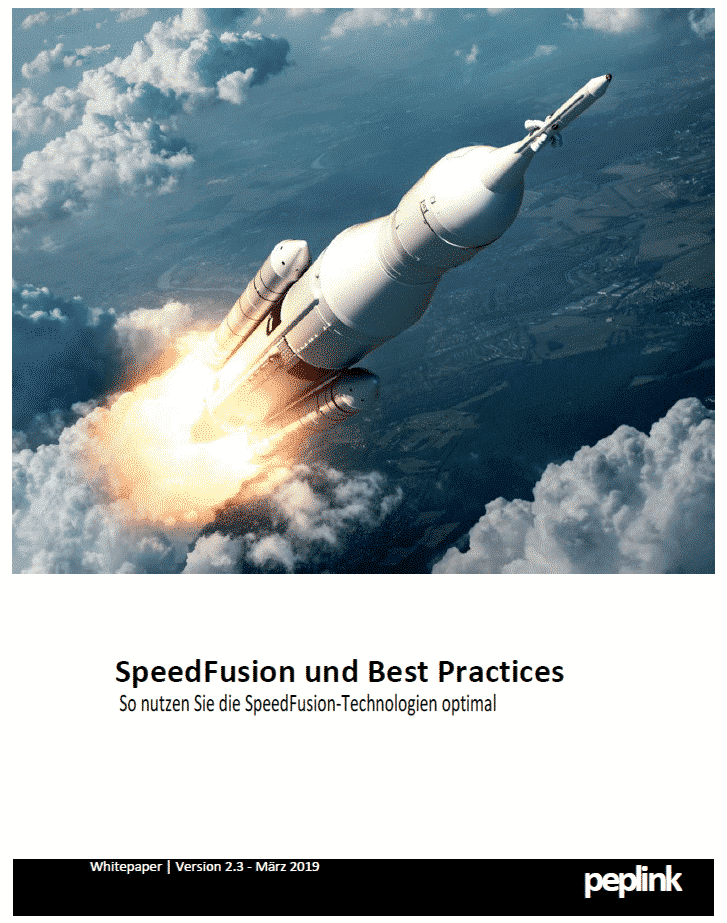
Ascend Hosted FusionHub vs. Cloud FusionHub.
Our Peplink Speedfusion Hubs hosted in Germany are specially optimized for streaming applications.
For example, many cloud providers automatically move the virtual machines from one hardware hypervisor to another hypervisor during the day when they need the resources.
However, as this can cause short-term latency peaks of approx. 200ms, we postpone such activities to the night hours.
Ascend permanently minimizes and monitors the latencies and packet losses of all components.
All our components have significantly more power than is required in regular operation and are available in redundant form.
At our location in the German data center, we have redundant fiber optic connections & power supplies.
Last but not least: If you need support during the deployment of your multi-WAN bonding router, we are happy to be there for you at short notice and can access all the components involved directly.
Peplink / InControl2 (4)
The easiest way is via https://incontrol.ascend.de
In rare cases, however, the router is displayed as offline although it should actually be online.
In these cases, the following can be checked/tried:
- Check whether the connection to the Fusionhub still exists.
- If necessary, set up a port forward here and use it to access the router's web interface
- Connect to the Fusionhub via VPN and from there to the router's web interface
- If the router has a public WAN IP, access can be attempted via this
- Access to the LAN IP via a connected PC
To set up a captive portal, you first need a VLAN. Just like the captive portal, the VLAN can be created at group level. To access the existing VLANs, simply click on the dashboard of a device group. New VLANs can also be created here.
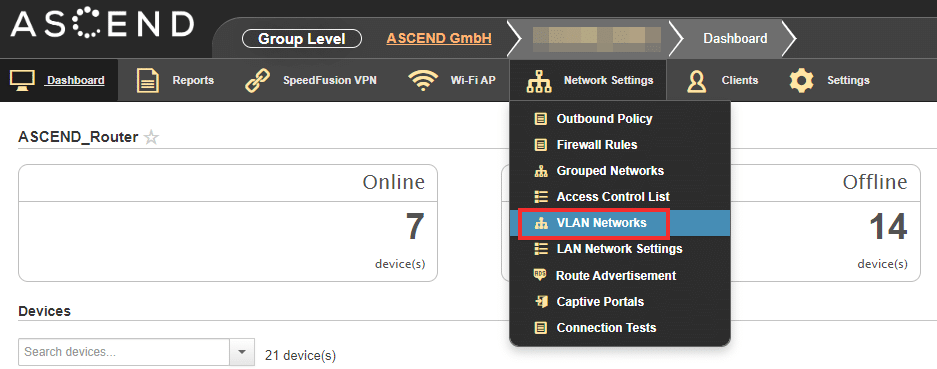
If a new VLAN needs to be created, simply click on "Add VLAN Network".
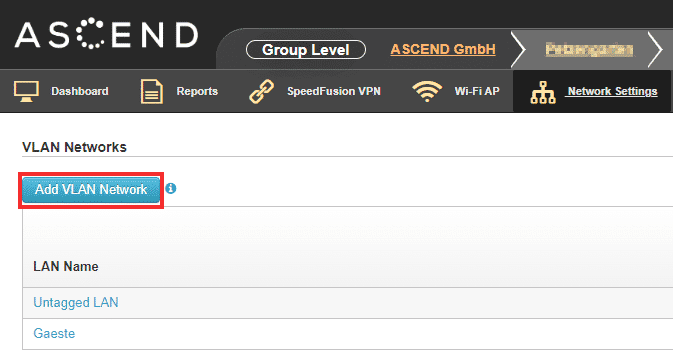
First, a name and a VLAN ID must be assigned.
Under "Apply to", you can control which devices within the group receive this VLAN. If the VLAN should only be made available for certain devices in the group, this can be achieved by using tags. The respective device can be tagged in the device details (by clicking on the router) via "Edit".
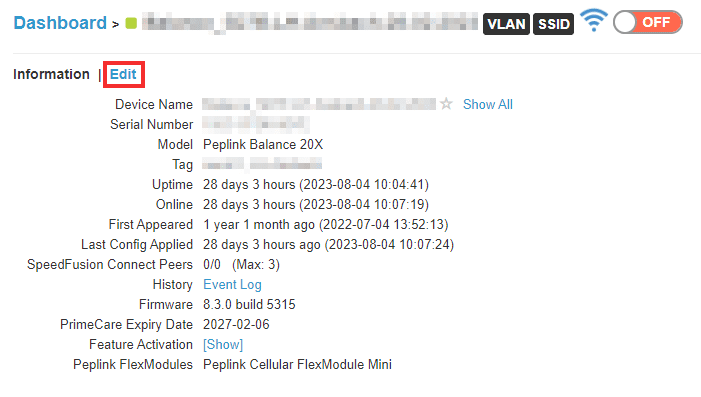

The information about which captive portal is to be used for this VLAN can be left blank if the portal has not yet been created.
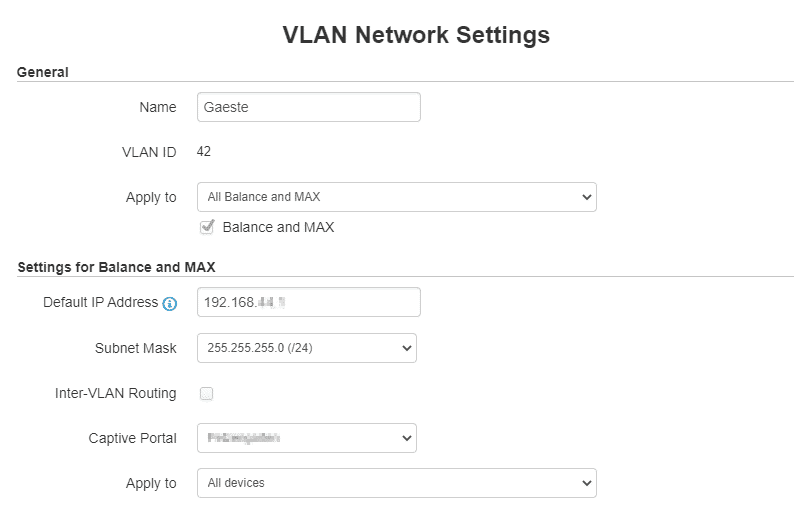
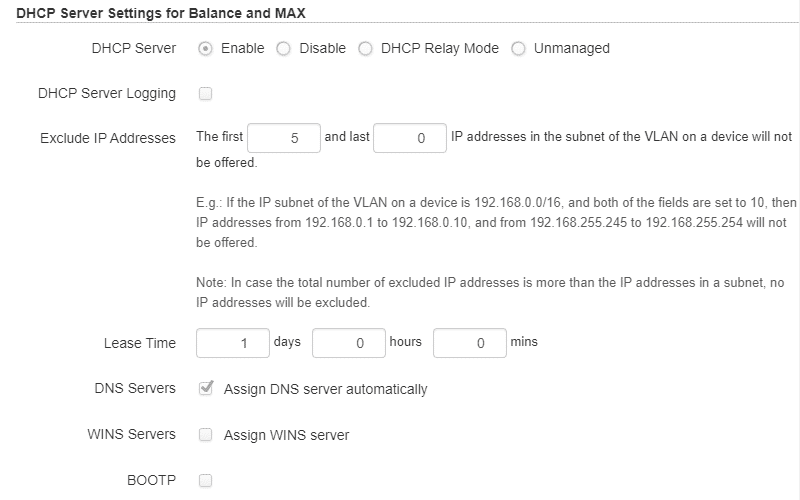
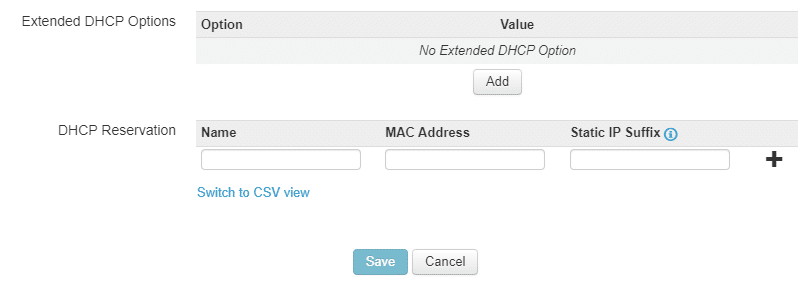
A new captive portal can now be created at group level.
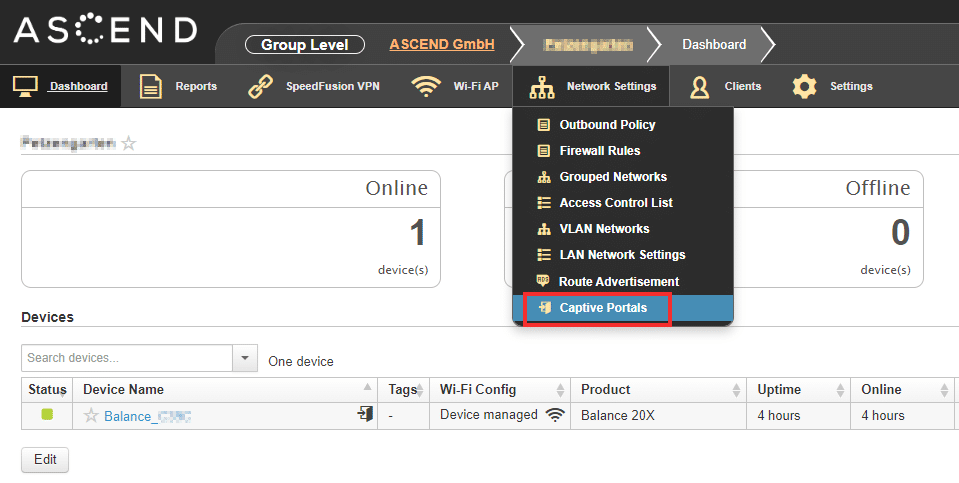
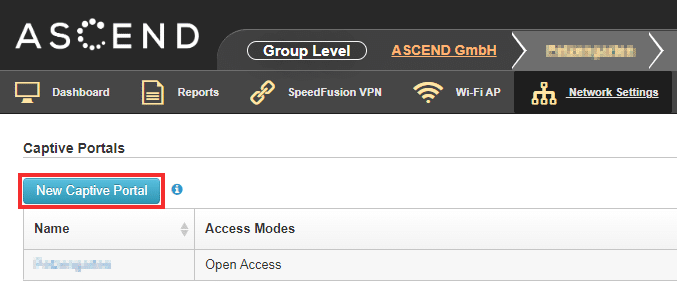
The "Open Access" access mode is best suited for testing the captive portal.
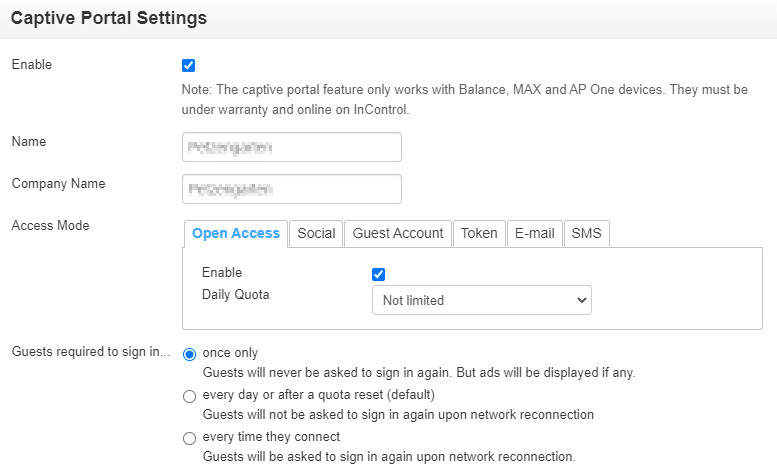
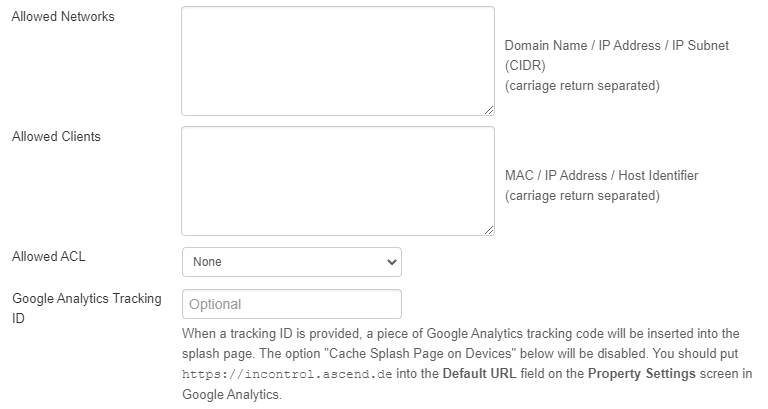
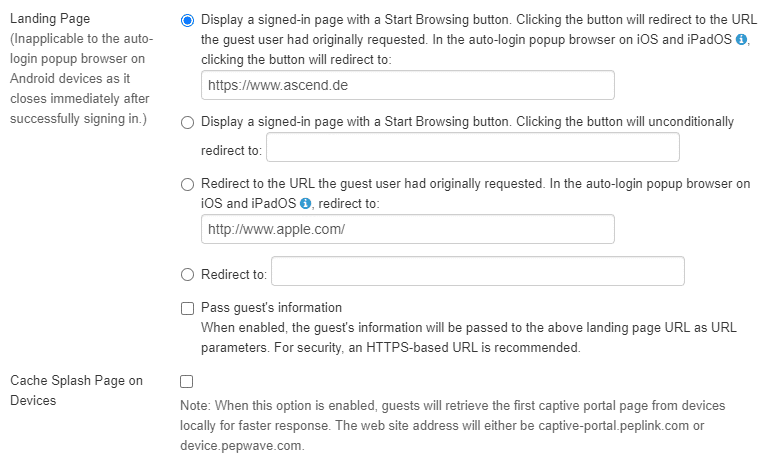

The design of the captive portal can now be customized via "Preview and Customization".

There is a splash screen and a signed-in screen.
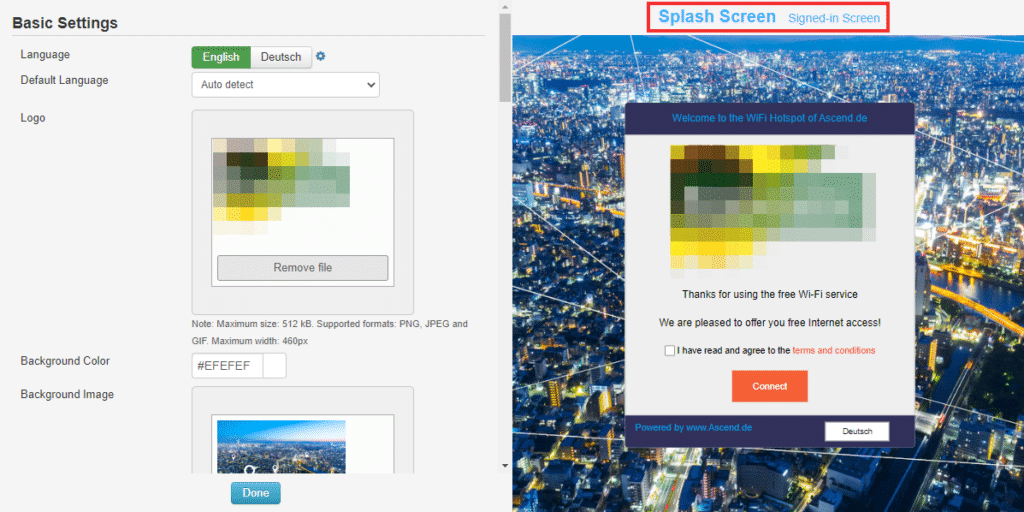
An additional language can be added using the small cogwheel.
You can also upload a logo and a background image.
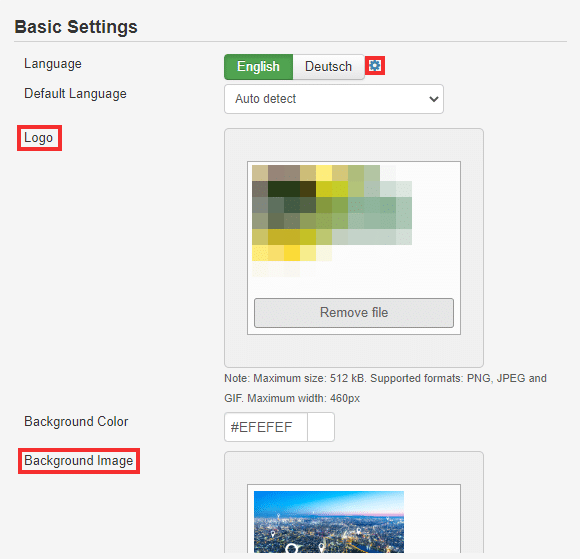
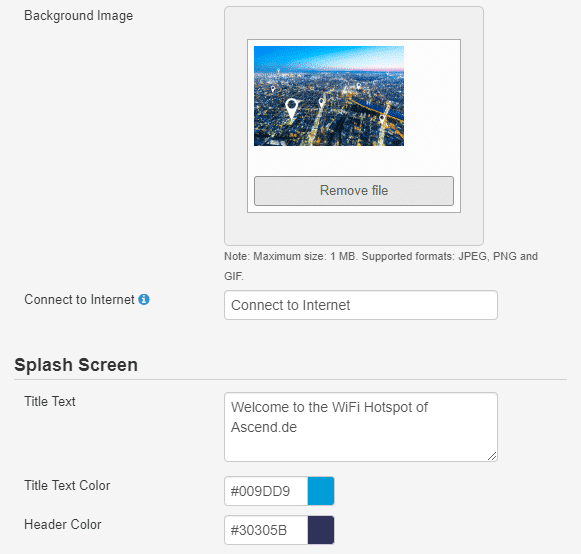
The colors are specified in HTML format (hex color code).
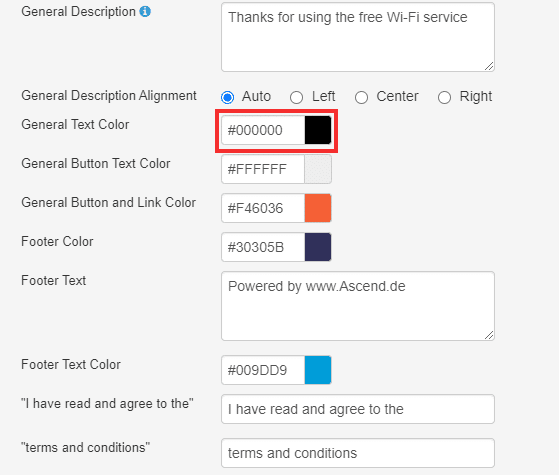
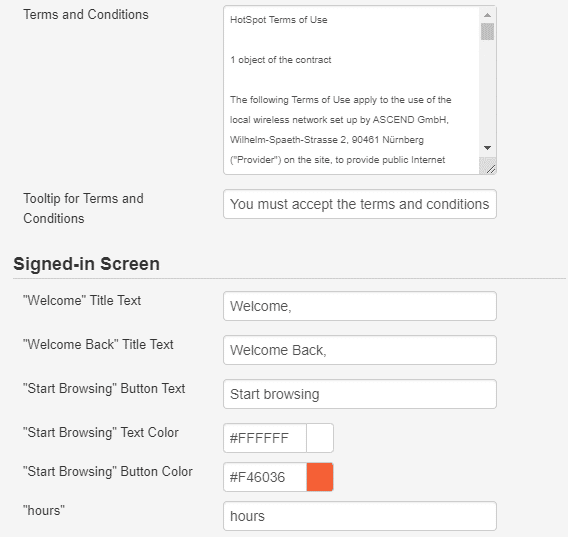
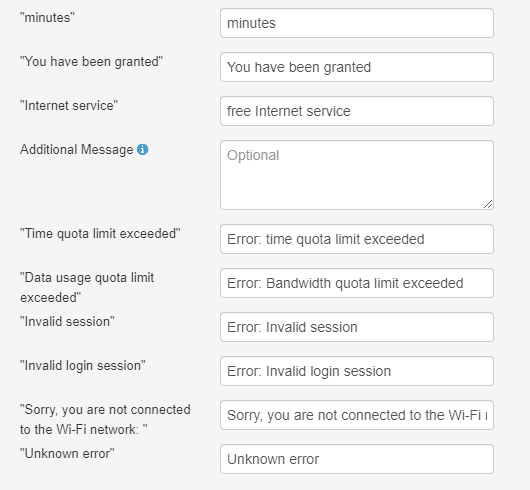
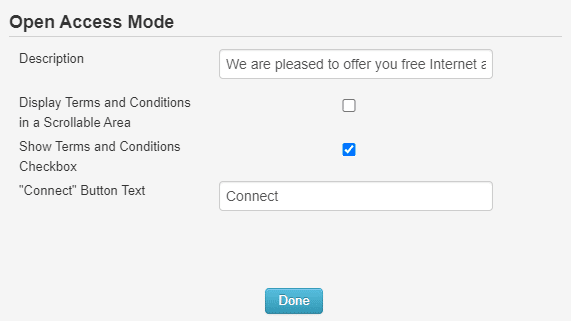
The splash screen contains the terms of use, which must be confirmed.
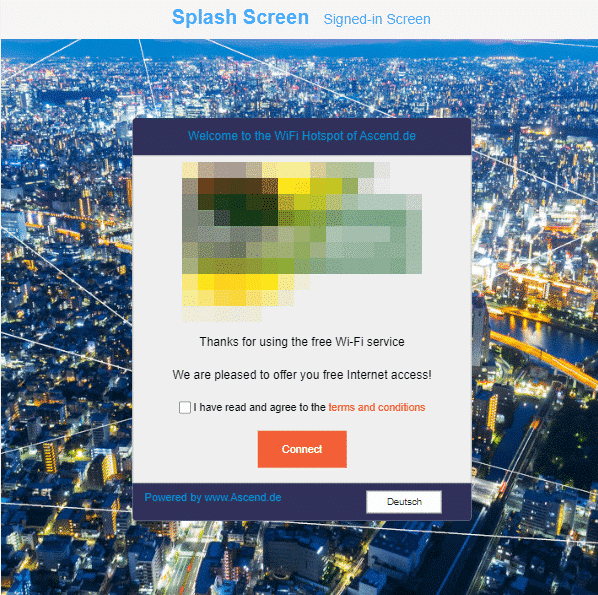
The text in the signed-in screen can be customized for connections with and without data limit.
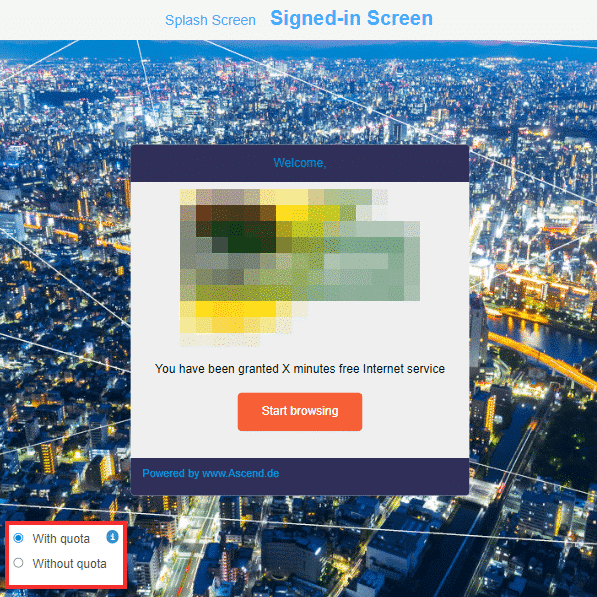
The desired captive portal can now also be selected in the VLAN and is therefore available.
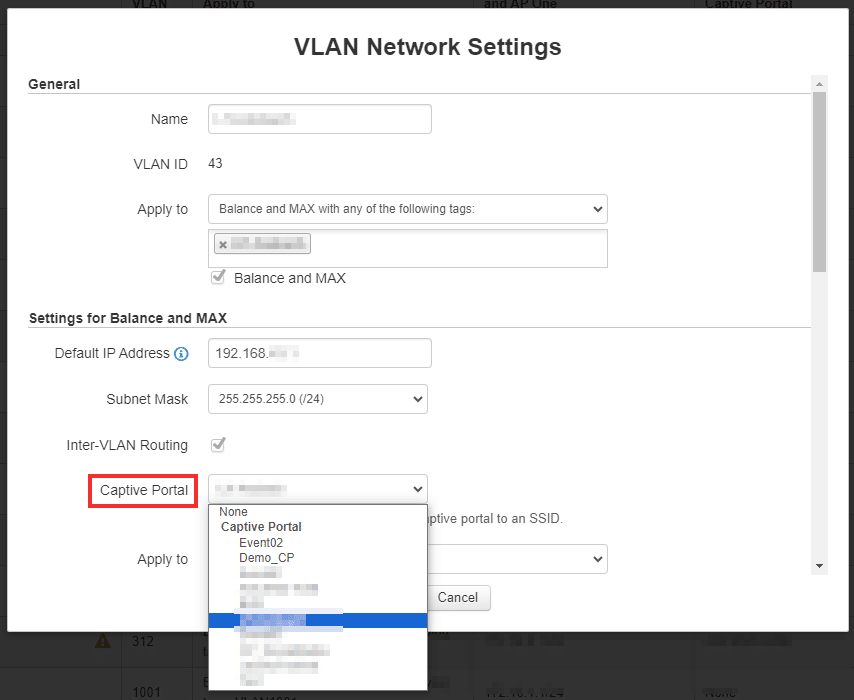
Set private InControl with Peplink
The first option, namely a redirection from Peplink InControl to the private InControl instance, has the advantage that routers with factory settings also report to our incontrol.ascend.de hosted in Germany.
To do this, log in to Peplink InControl via the following link https://peplinkid.peplink.com log in.
After your authentication, click on "InControl 2" on this website
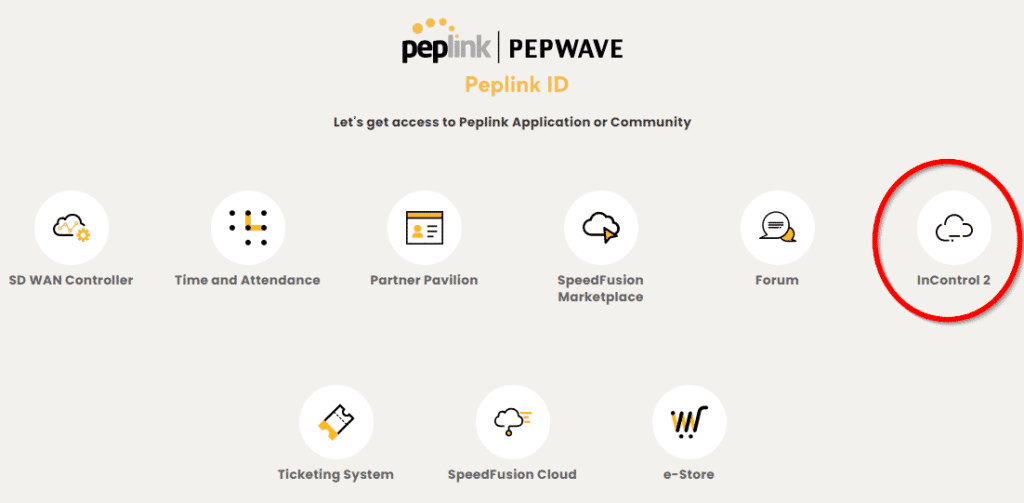
Then click on the organization

Then click on the group in which your routers are located that you want to use with the private Peplink InControl 2
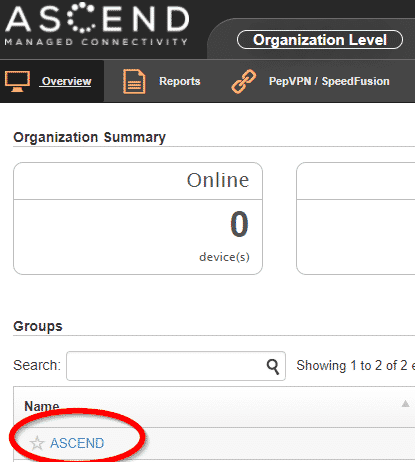
Within the group, move the mouse to "Settings (1)" and then click on "Device System Management (2)".
Then select "By Redirection" (3) under "Use External InControl Appliance" and enter "incontrol.ascend.de" (4) in "Primary Appliance Address".
If you now click on "Save Changes" (5), all Peplink devices that report to the public Peplink InControl2 will be redirected to "incontrol.ascend.de".
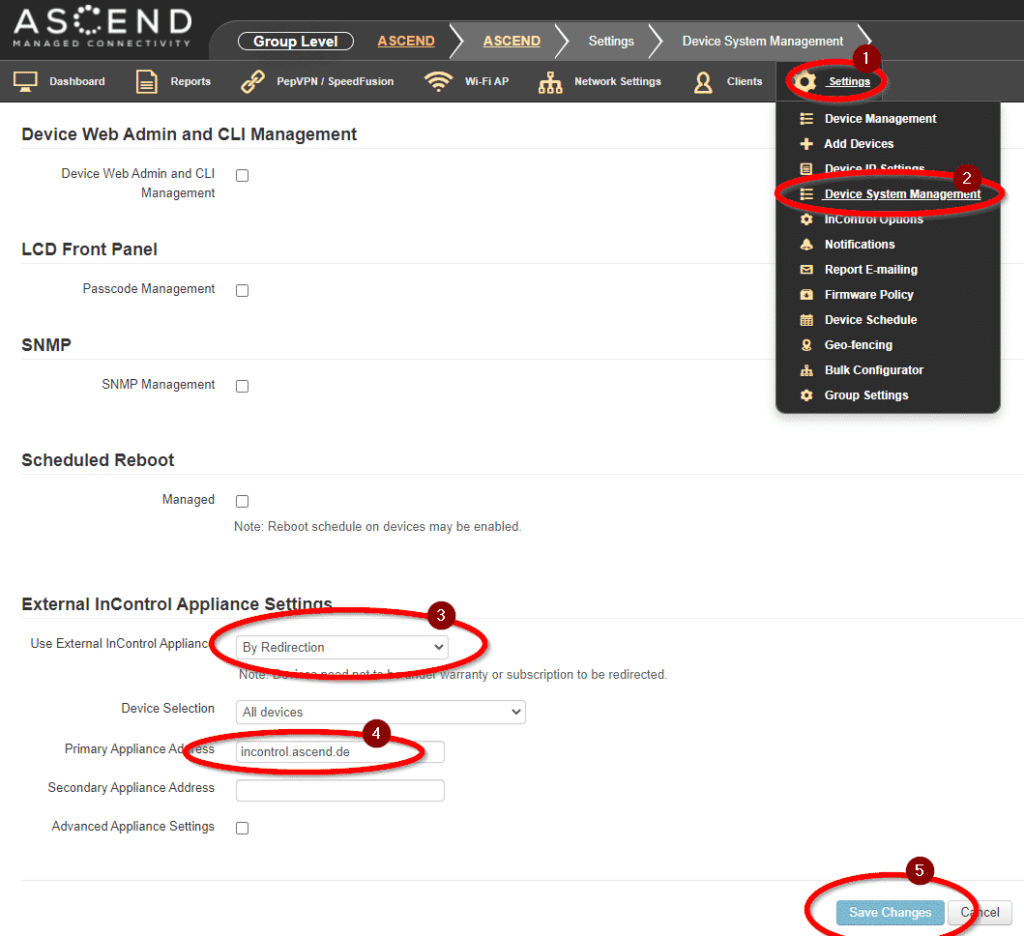
Set private InControl on the device
The 2nd option, setting the private InControl to on the device, has the disadvantage that the device no longer reports to the private Peplink InControl2 in the event of a reset. For the sake of completeness, we explain it here anyway.
Log in to the web interface of your Peplink router.
Click on "System"(1) at the top, then on "InControl"(2) on the left, check the box "Privately Host InControl" (3), enter "incontrol.ascend.de" under "InControl Host" and click on "Save"(5).
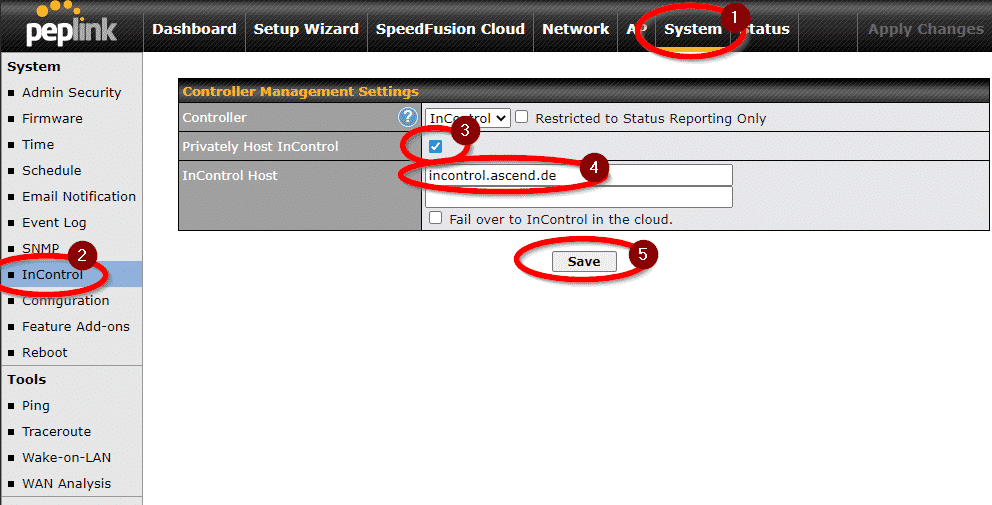
Now the router will report to the private InControl hosted in Germany.
Peplink / MBX 5G (1)
| Used in Germany | EXM-MBX-T2-5GD | Ribbon | Duplex mode[A 1] | ƒ (MHz) | Common name | Subset of band | Uplink[A 2] (MHz) | Downlink[A 3] (MHz) | Duplex spacing (MHz) | Channel bandwidths[A 4] (MHz) | Notes |
| GER | MBX5G | n1 | FDD | 2100 | IMT | 1920 - 1980 | 2110 - 2170 | 190 | 5, 10, 15, 20, 25, 30, 40, 45, 50 | ||
| MBX5G | n2 | FDD | 1900 | PCS | n25 | 1850 - 1910 | 1930 - 1990 | 80 | 5, 10, 15, 20, 25, 30, 35, 40 | ||
| MBX5G | n3 | FDD | 1800 | DCS | 1710 - 1785 | 1805 - 1880 | 95 | 5, 10, 15, 20, 25, 30, 35, 40, 45, 50 | |||
| MBX5G | n5 | FDD | 850 | CLR | n26 | 824 - 849 | 869 - 894 | 45 | 5, 10, 15, 20, 25[B 1] | ||
| MBX5G | n7 | FDD | 2600 | IMT-E | 2500 - 2570 | 2620 - 2690 | 120 | 5, 10, 15, 20, 25, 30, 35, 40, 50 | |||
| MBX5G | n8 | FDD | 900 | Extended GSM | 880 - 915 | 925 - 960 | 45 | 5, 10, 15, 20, 35[B 1] | |||
| MBX5G | n12 | FDD | 700 | Lower SMH | n85 | 699 - 716 | 729 - 746 | 30 | 5, 10, 15 | ||
| n13 | FDD | 700 | Upper SMH | 777 - 787 | 746 - 756 | -31 | 5, 10 | ||||
| n14 | FDD | 700 | Upper SMH | 788 - 798 | 758 - 768 | -30 | 5, 10 | ||||
| n18 | FDD | 850 | Lower 800 (Japan) | n26 | 815 - 830 | 860 - 875 | 45 | 5, 10, 15 | |||
| MBX5G | n20 | FDD | 800 | Digital Dividend (EU) | 832 - 862 | 791 - 821 | -41 | 5, 10, 15, 20 | |||
| n24 | FDD | 1600 | Upper L-Band (US) | 1626.5 - 1660.5[B 2] | 1525 - 1559[B 3] | -101.5 | 5, 10 | ||||
| n25 | FDD | 1900 | Extended PCS | 1850 - 1915 | 1930 - 1995 | 80 | 5, 10, 15, 20, 25, 30, 35, 40, 45[B 1] | ||||
| n26 | FDD | 850 | Extended CLR | 814 - 849 | 859 - 894 | 45 | 5, 10, 15, 20 | ||||
| n28 | FDD | 700 | APT | 703 - 748 | 758 - 803 | 55 | 5, 10, 15, 20, 30 | ||||
| n29 | SDL | 700 | Lower SMH | N/A | 717 - 728 | N/A | 5, 10 | ||||
| n30 | FDD | 2300 | WCS | 2305 - 2315 | 2350 - 2360 | 45 | 5, 10 | ||||
| n34 | TDD | 2100 | IMT | 2010 - 2025 | N/A | 5, 10, 15 | |||||
| MBX5G | n38 | TDD | 2600 | IMT-E[B 4] | 2570 - 2620 | N/A | 5, 10, 15, 20, 25, 30, 40 | ||||
| n39 | TDD | 1900 | DCS-IMT Gap | 1880 - 1920 | N/A | 5, 10, 15, 20, 25, 30, 40 | |||||
| n40 | TDD | 2300 | S-band | 2300 - 2400 | N/A | 5[B 5], 10, 15, 20, 25, 30, 40, 50, 60, 80, 90, 100 | |||||
| MBX5G | n41 | TDD | 2500 | BRS | 2496 - 2690 | N/A | 10, 15, 20, 30, 40, 50, 60, 70, 80, 90, 100 | ||||
| n46 | TDD | 5200 | U-NII-1-4 | 5150 - 5925 | N/A | 10[B 6], 20, 40, 60, 80 | LAA | ||||
| n47 | TDD | 5900 | U-NII-4 | 5855 - 5925 | N/A | 10, 20, 30, 40 | V2X | ||||
| n48 | TDD | 3500 | CBRS (US) | 3550 - 3700 | N/A | 5[B 5], 10, 15, 20, 30, 40, 50[B 6], 60[B 6], 70[B 6], 80[B 6], 90[B 6], 100[B 6] | |||||
| n50 | TDD | 1500 | L-band (EU) | 1432 - 1517 | N/A | 5[B 5], 10, 15, 20, 30, 40, 50, 60, 80[B 1] | |||||
| n51 | TDD | 1500 | L-Band Extension (EU) | 1427 - 1432 | N/A | 5 | |||||
| n53 | TDD | 2400 | S band | 2483.5 - 2495 | N/A | 5, 10 | |||||
| n65 | FDD | 2100 | Extended IMT | 1920 - 2010 | 2110 - 2200 | 190 | 5, 10, 15, 20, 50 | ||||
| MBX5G | n66 | FDD | 1700 2100 | Extended AWS | 1710 - 1780 | 2110 - 2200[B 7] | 400 | 5, 10, 15, 20, 25, 30, 35, 40, 45 | [B 8] | ||
| n67 | SDL | 700 | EU 700 | N/A | 738 - 758 | N/A | 5, 10, 15, 20 | ||||
| n70 | FDD | 2000 | Supplementary AWS | 1695 - 1710 | 1995 - 2020 | 300 | 5, 10, 15, 20[B 1], 25[B 1] | [B 8] | |||
| MBX5G | n71 | FDD | 600 | Digital Dividend (US) | 663 - 698 | 617 - 652 | -46 | 5, 10, 15, 20, 25[B 1], 30[B 1], 35[B 1] | [B 8] | ||
| n74 | FDD | 1500 | Lower L-Band (US) | 1427 - 1470 | 1475 - 1518 | 48 | 5, 10, 15, 20 | ||||
| n75 | SDL | 1500 | L-band (EU) | N/A | 1432 - 1517 | N/A | 5, 10, 15, 20, 25, 30, 40, 50 | ||||
| n76 | SDL | 1500 | Extended L-Band (EU) | N/A | 1427 - 1432 | N/A | 5 | ||||
| MBX5G | n77 | TDD | 3700 | C-Band | 3300 - 4200 | N/A | 10, 15, 20, 25, 30, 40, 50, 60, 70, 80, 90, 100 | ||||
| GER | MBX5G | n78 | TDD | 3500 | C-Band | n77 | 3300 - 3800 | N/A | 10, 15, 20, 25, 30, 40, 50, 60, 70, 80, 90, 100 | ||
| MBX5G | n79 | TDD | 4700 | C-Band | 4400 - 5000 | N/A | 10, 20, 30, 40, 50, 60, 70, 80, 90, 100 | ||||
| n80 | SUL | 1800 | DCS | 1710 - 1785 | N/A | N/A | 5, 10, 15, 20, 25, 30, 40 | ||||
| n81 | SUL | 900 | Extended GSM | 880 - 915 | N/A | N/A | 5, 10, 15, 20 | ||||
| n82 | SUL | 800 | Digital Dividend (EU) | 832 - 862 | N/A | N/A | 5, 10, 15, 20 | ||||
| n83 | SUL | 700 | APT | 703 - 748 | N/A | N/A | 5, 10, 15, 20, 30 | ||||
| n84 | SUL | 2100 | IMT | 1920 - 1980 | N/A | N/A | 5, 10, 15, 20, 25, 30, 40, 50 | ||||
| n85 | FDD | 700 | Extended Lower SMH | 698 - 716 | 728 - 746 | 30 | 5, 10, 15 | ||||
| n86 | SUL | 1700 | Extended AWS | n80 | 1710 - 1780 | N/A | N/A | 5, 10, 15, 20, 40 | |||
| n89 | SUL | 850 | CLR | 824 - 849 | N/A | N/A | 5, 10, 15, 20, 50 (sic) | ||||
| n90 | TDD | 2500 | BRS | n41 | 2496 - 2690 | N/A | 10, 15, 20, 30, 40, 50, 60, 80, 90, 100 | ||||
| n91 | FDD | 800 1500 | DD (EU) L-band (EU) | 832 - 862 | 1427 - 1432 | 570 - 595[B 9] | 5, 10[B 10] | [B 8] | |||
| n92 | FDD | 800 1500 | DD (EU) L-band (EU) | 832 - 862 | 1432 - 1517 | 600 - 660[B 9] | 5, 10, 15, 20 | [B 8] | |||
| n93 | FDD | 900 1500 | Extended GSM L-Band (EU) | 880 - 915 | 1427 - 1432 | 527 - 547[B 9] | 5, 10[B 10] | [B 8] | |||
| n94 | FDD | 900 1500 | Extended GSM L-Band (EU) | 880 - 915 | 1432 - 1517 | 532 - 632[B 9] | 5, 10, 15, 20 | [B 8] | |||
| n95 | SUL | 2100 | IMT | 2010 - 2025 | N/A | N/A | 5, 10, 15 | ||||
| n96 | TDD | 6000 | U-NII-5-9 | 5925 - 7125 | N/A | 20, 40, 60, 80 | LAA | ||||
| n97 | SUL | 2300 | S-band | 2300 - 2400 | N/A | N/A | 5, 10, 15, 20, 25, 30, 40, 50, 60, 70, 80, 90, 100 | ||||
| n98 | SUL | 1900 | DCS-IMT Gap | 1880 - 1920 | N/A | N/A | 5, 10, 15, 20, 25, 30, 40 | ||||
| n99 | SUL | 1600 | Upper L-Band (US) | 1626.5 - 1660.5[B 2] | N/A | N/A | 5, 10 |
| by Ascend GmbH | JF | 26.01.2022 | All statements without guarantee |
| Table Source: https://en.wikipedia.org/wiki/5G_NR_frequency_bands |
| MBX5G | Supported | according to: http://download.peplink.com/resources/pepwave_mbx_5g_5gd_datasheet.pdf |
| GER | Bands used in Germany | source: https://www.everythingrf.com/community/5g-frequency-spectrum-in-germany |
Satelliteninternet (1)
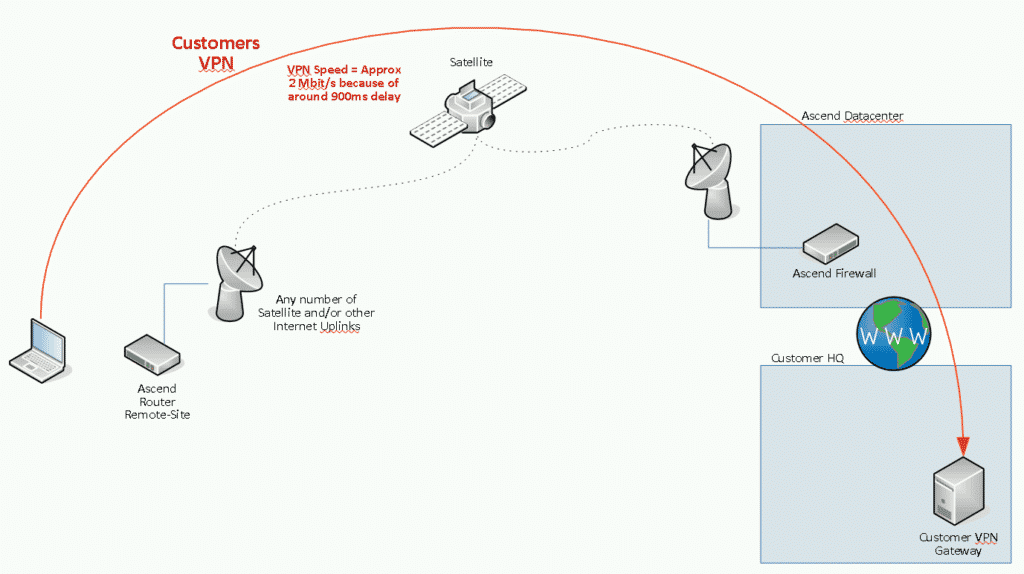
Due to the high latency of 700 ms to 2000 ms, VPN tunnels via satellite connections are usually extremely slow.
This is because the server waits for confirmation from the recipient that it has received all data packets.
If the server does not receive a confirmation, it stops sending data until it has received the confirmation.
Due to the delay of approx. 800 ms, the server always sends a bit, waits again, sends again and so on.
The data rate that is thus achieved is approx. 2-3 Mbit/s.
To solve this, we have the following solution:

We terminate the customer's VPN connection at our firewall in the data center and then establish encrypted connections via the satellite connection(s) to the remote peer.
From there, the connection is also encrypted, if required, to the customer's end device.
This enables us to optimize the data traffic for transmission via satellite.
VPN (1)
Here is the respective link to download:
For Windows 10:
https://openvpn.net/client/client-connect-vpn-for-windows/
For Apple:
https://openvpn.net/client-connect-vpn-for-mac-os/
Address
Wilhelm-Spaeth-Strasse 2
90461 Nuremberg
Social media
Hotline
Germany only
0800-1488750
International
+49 911-148875-20
WhatsApp
+49 (0)911 148875-0
The opening hours
Monday to Friday, 09:00 to 18:00




